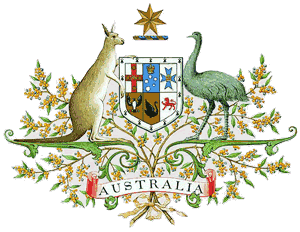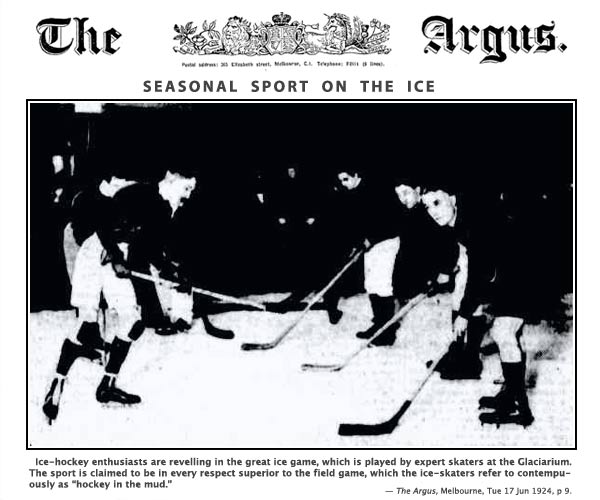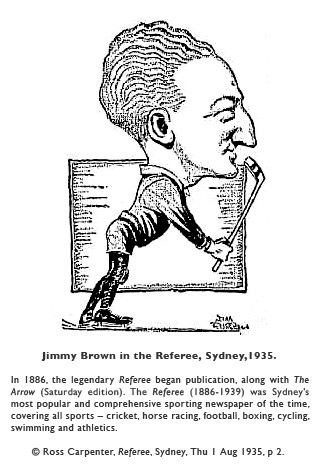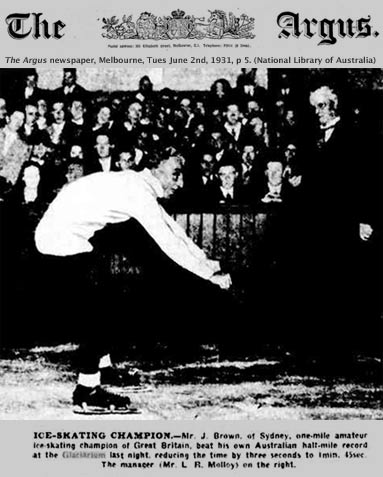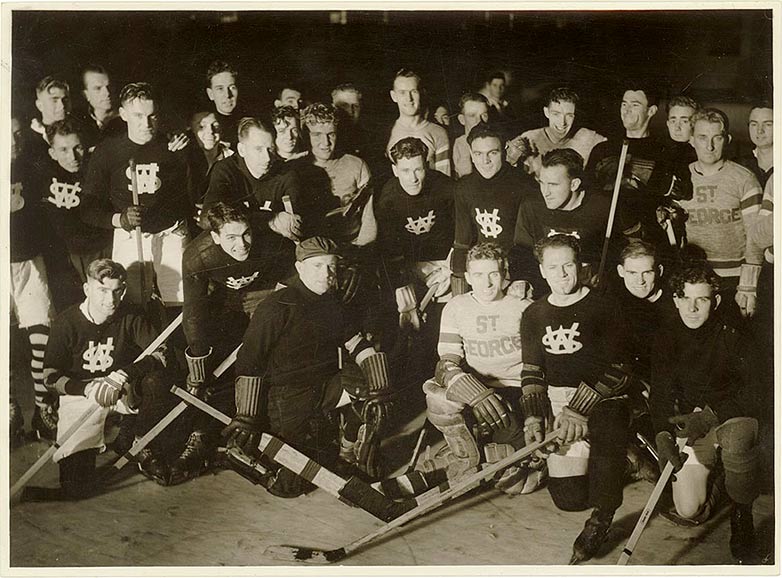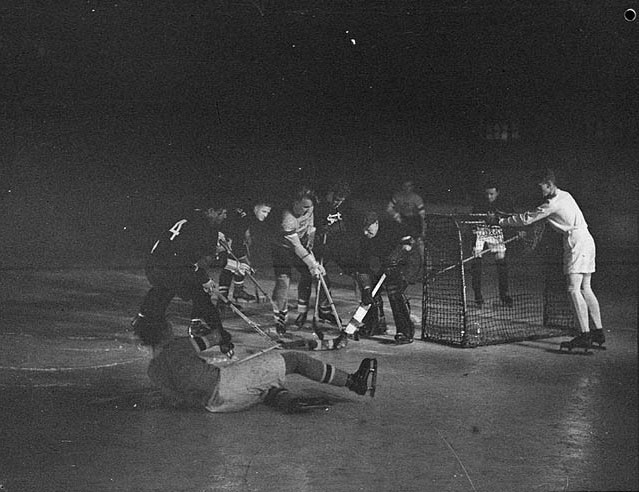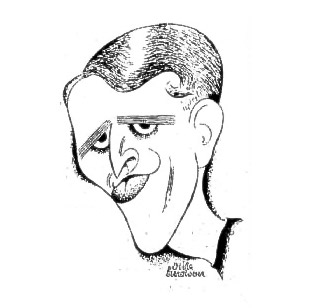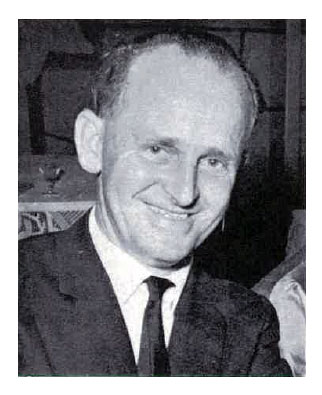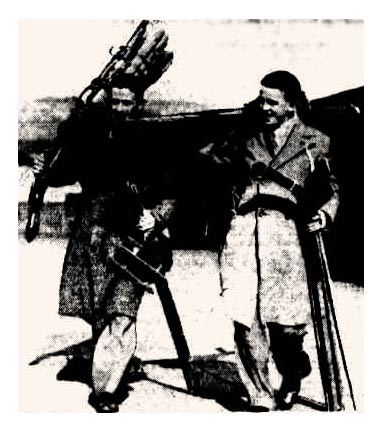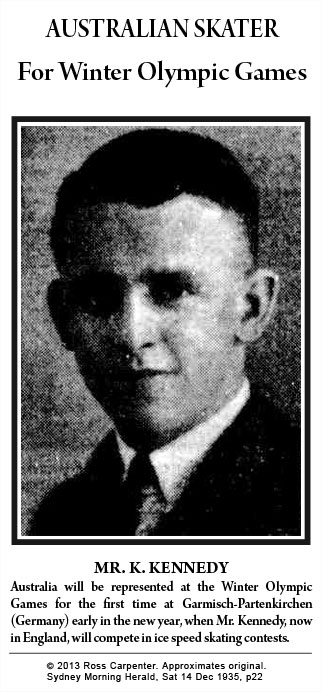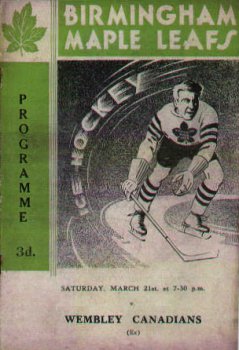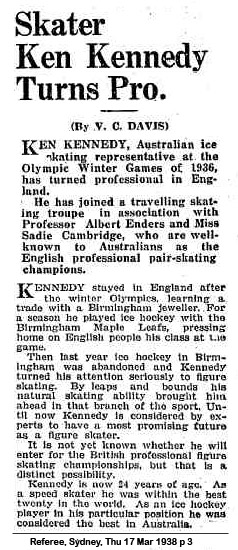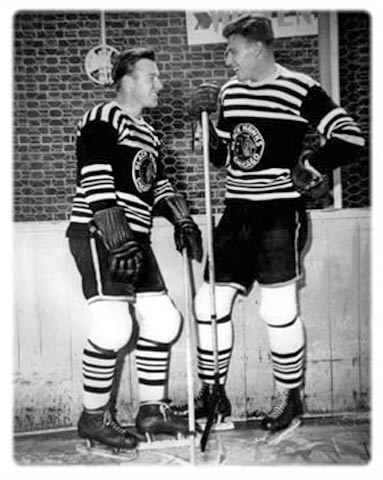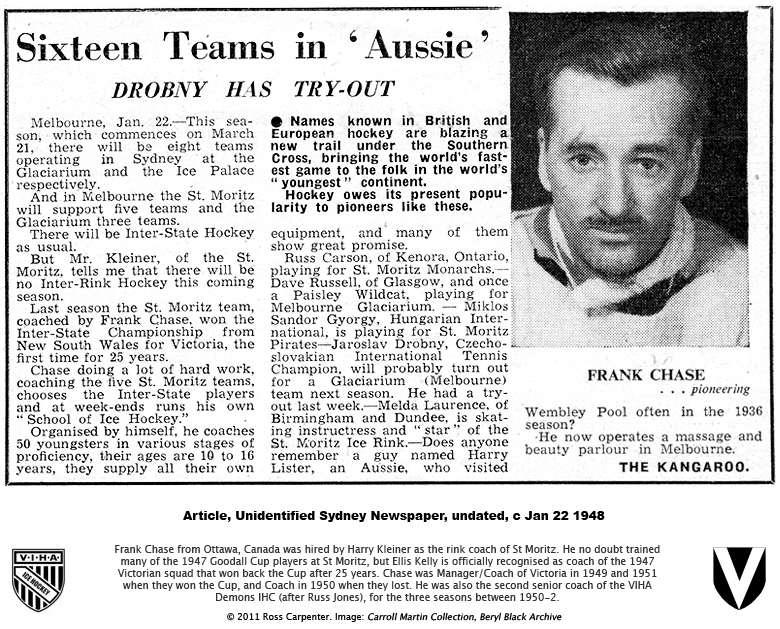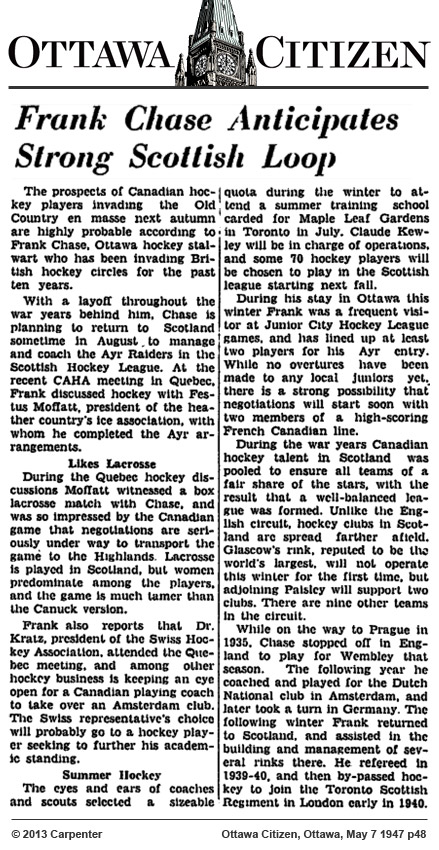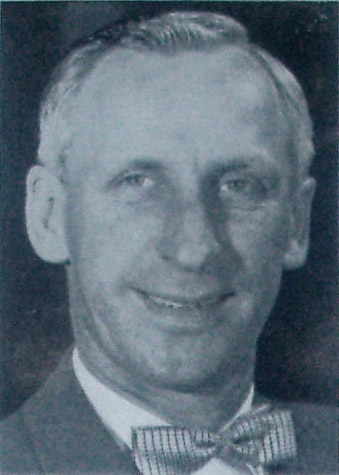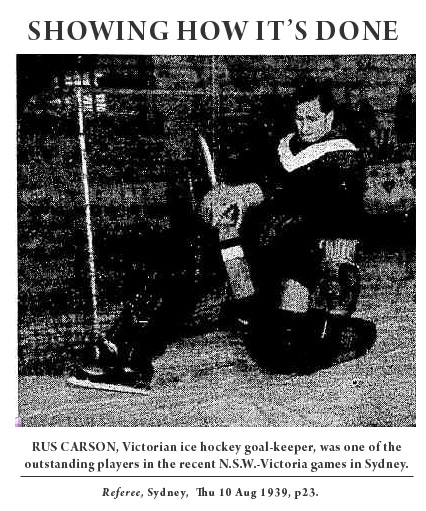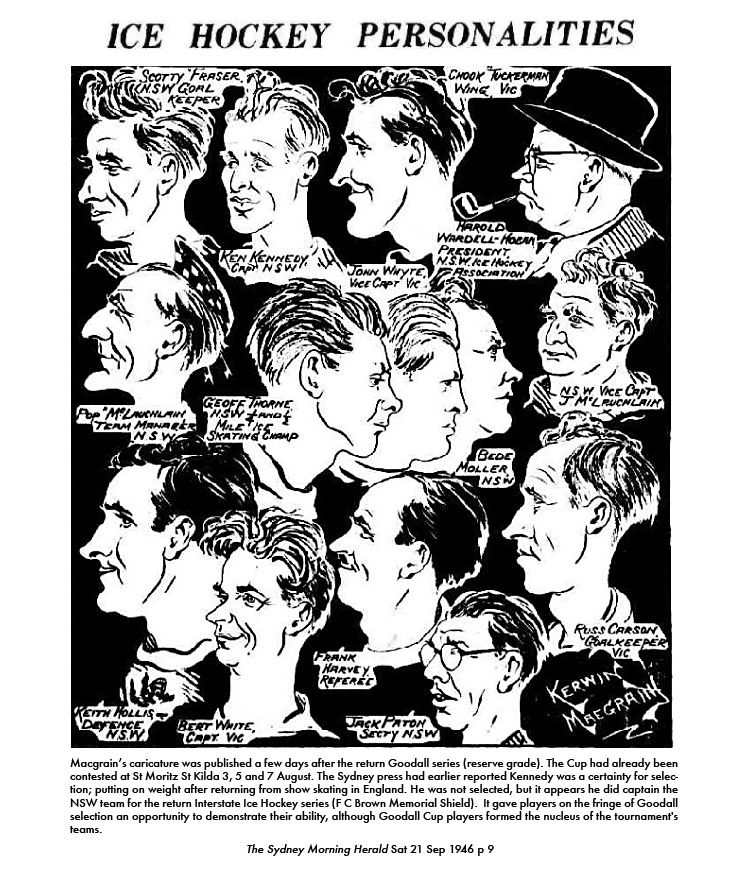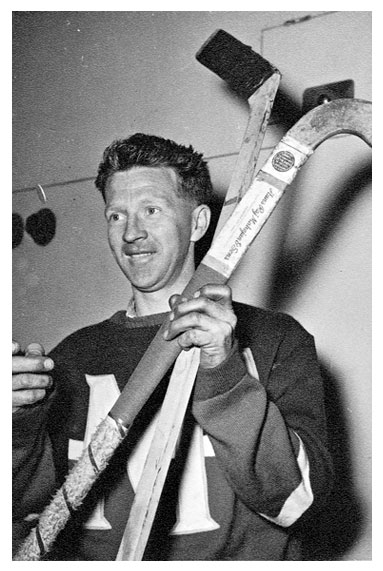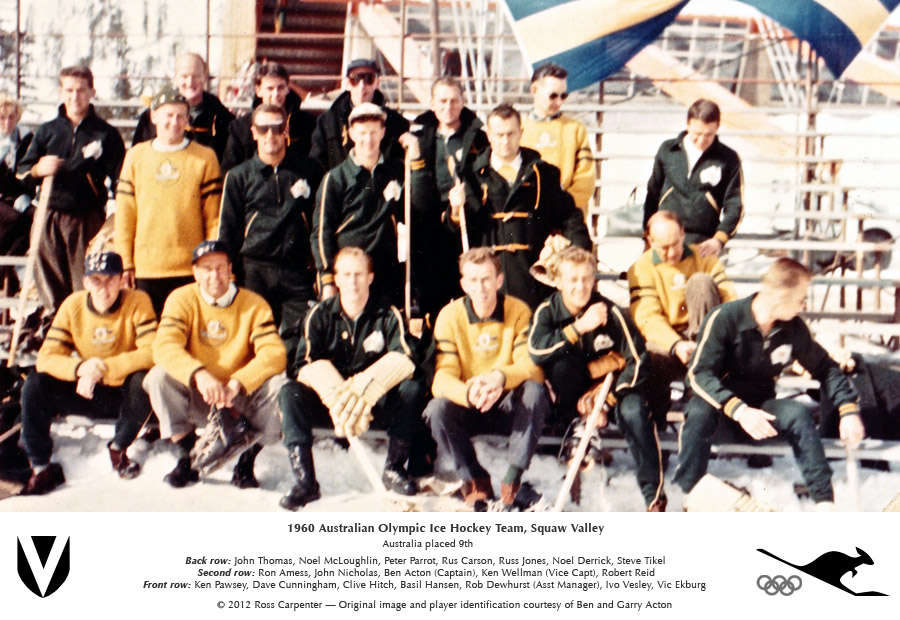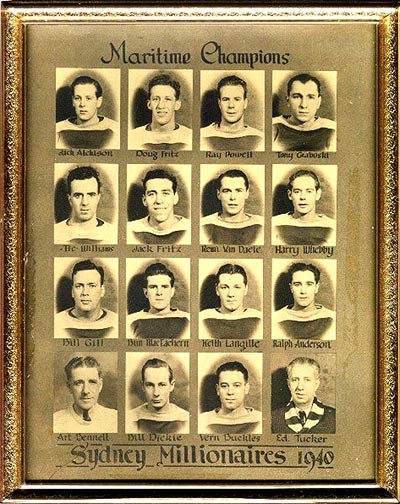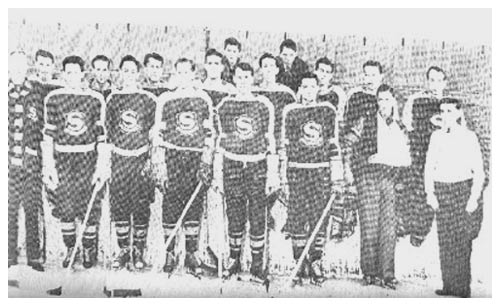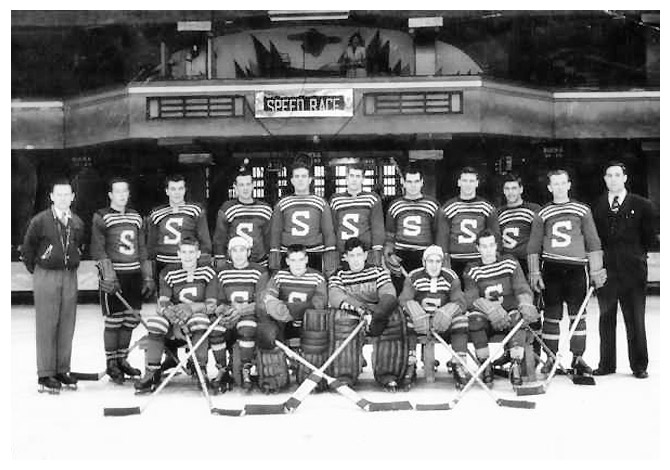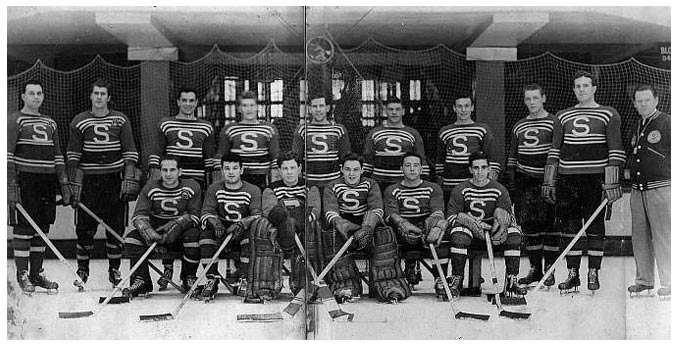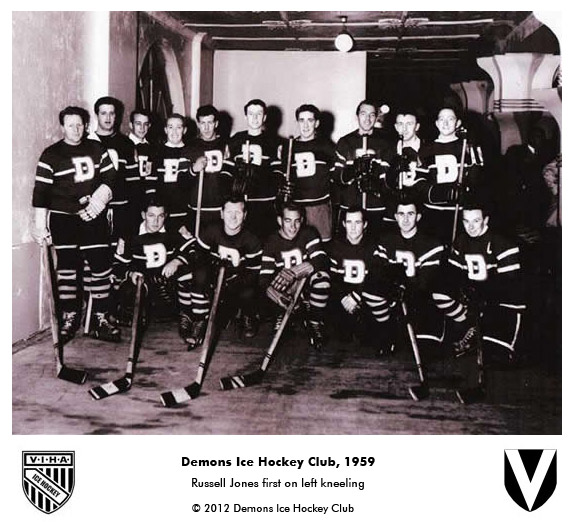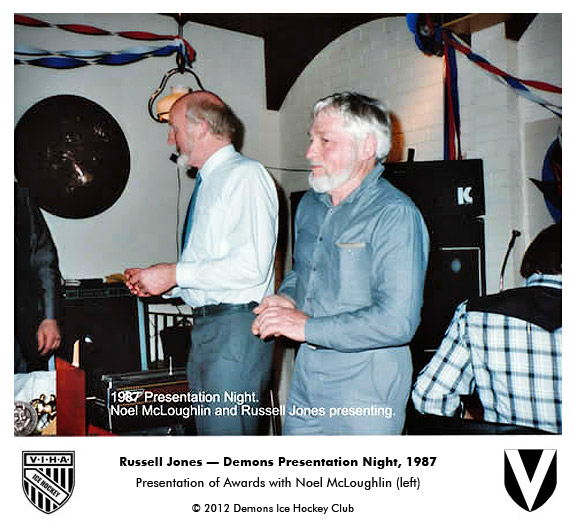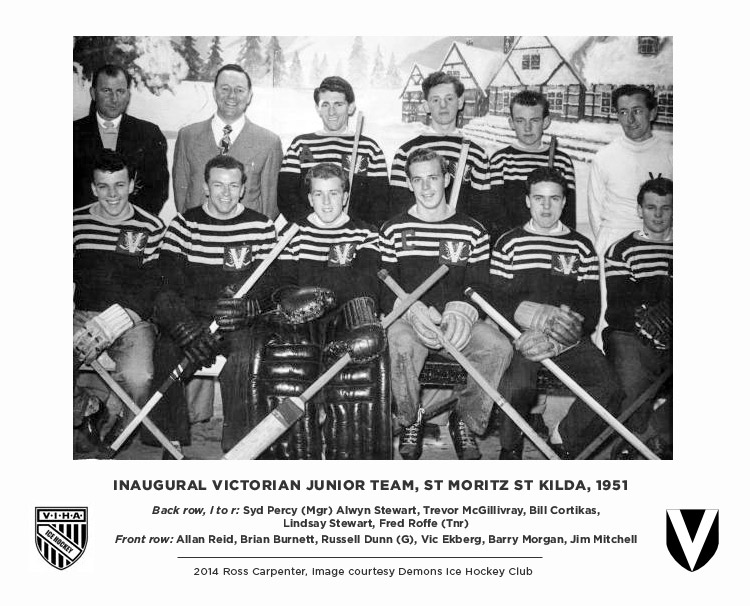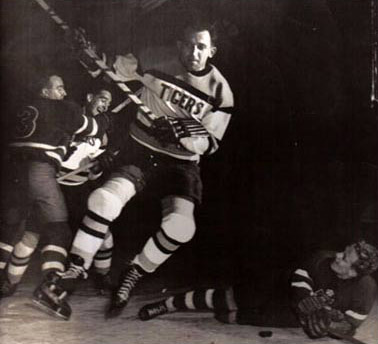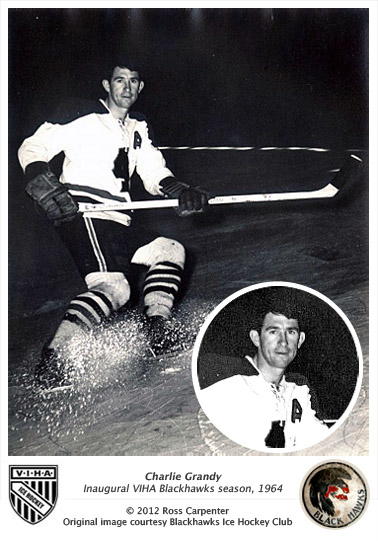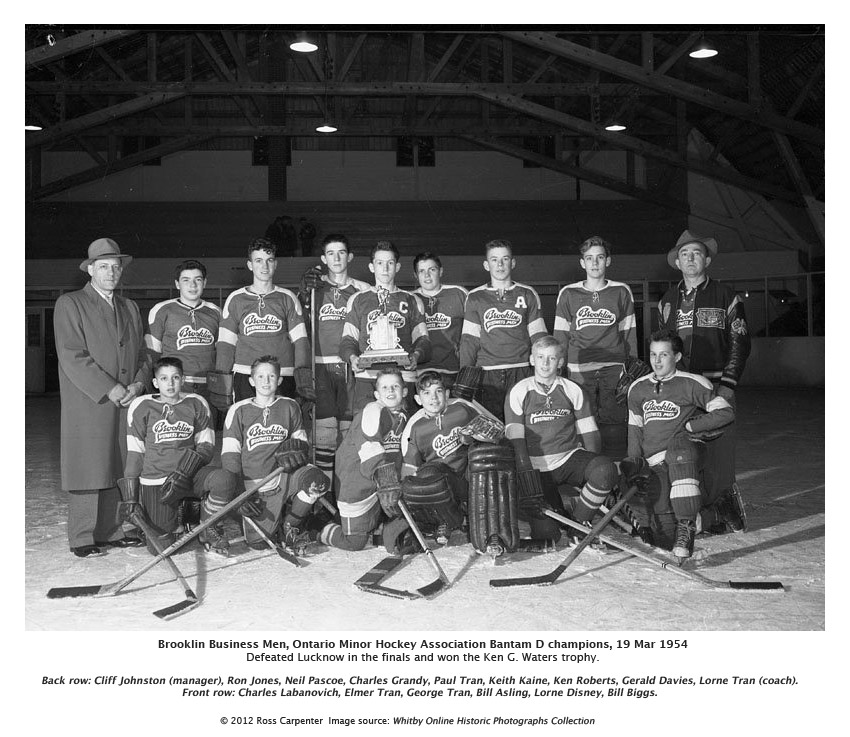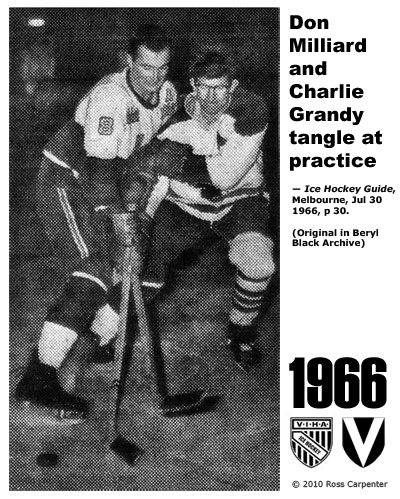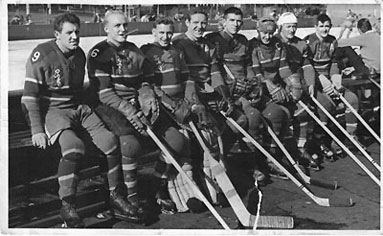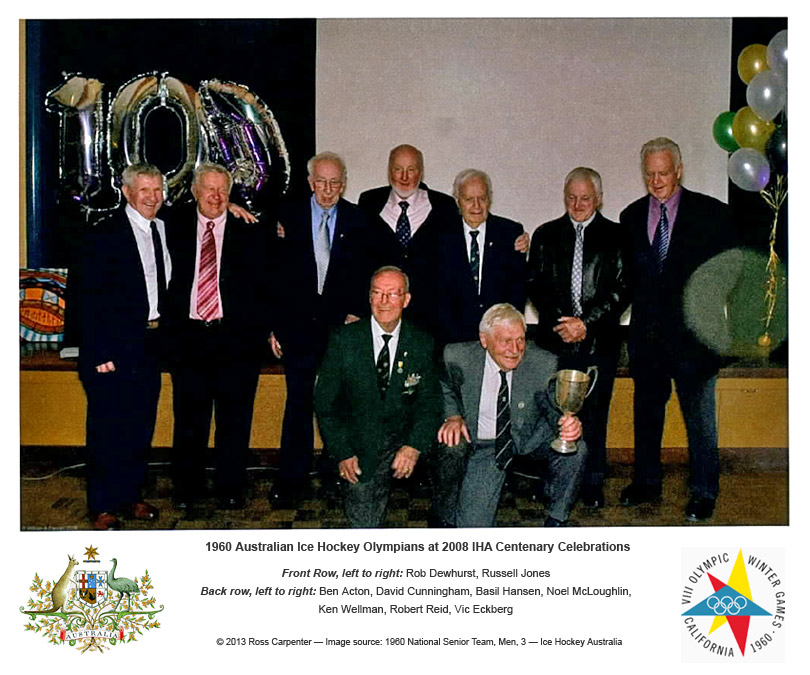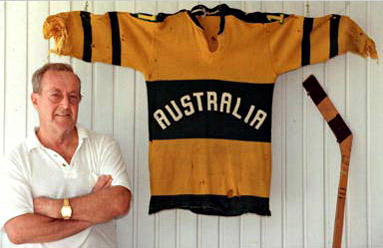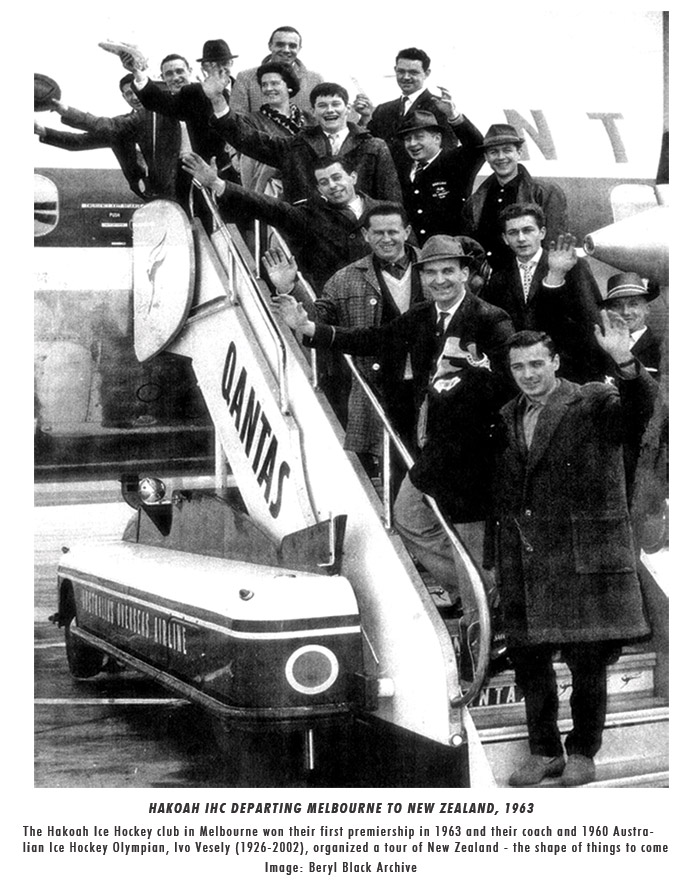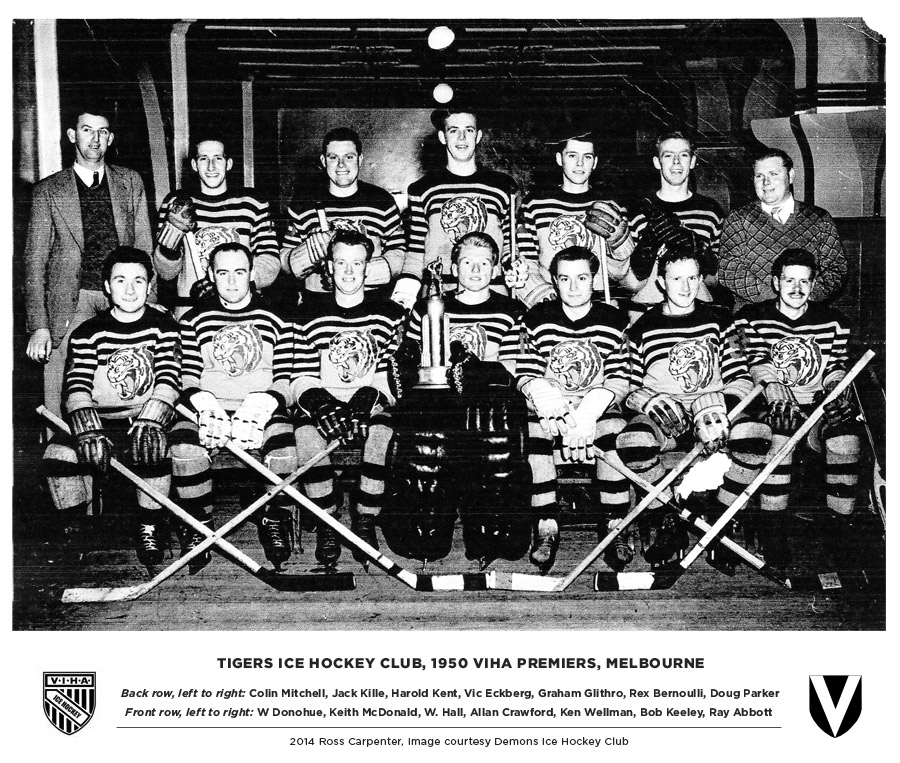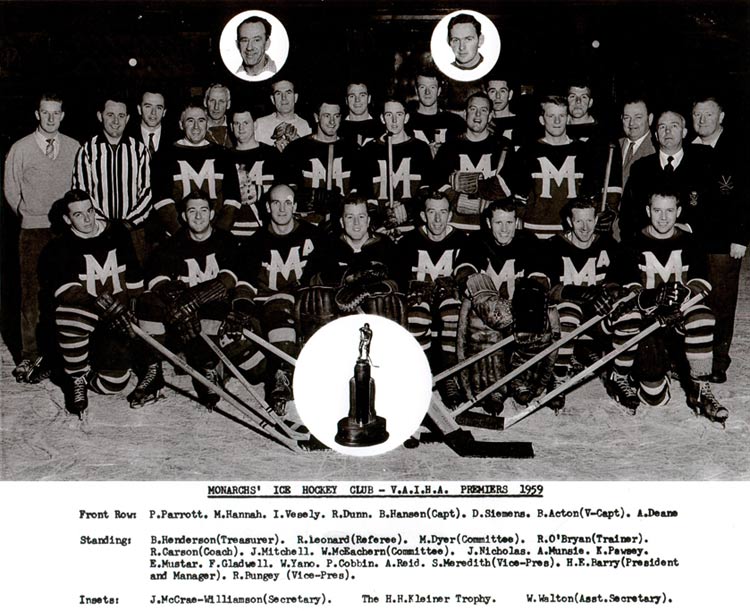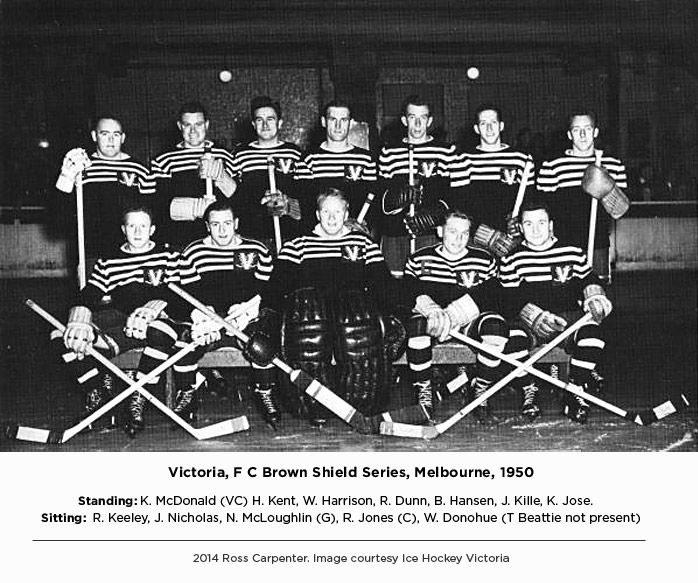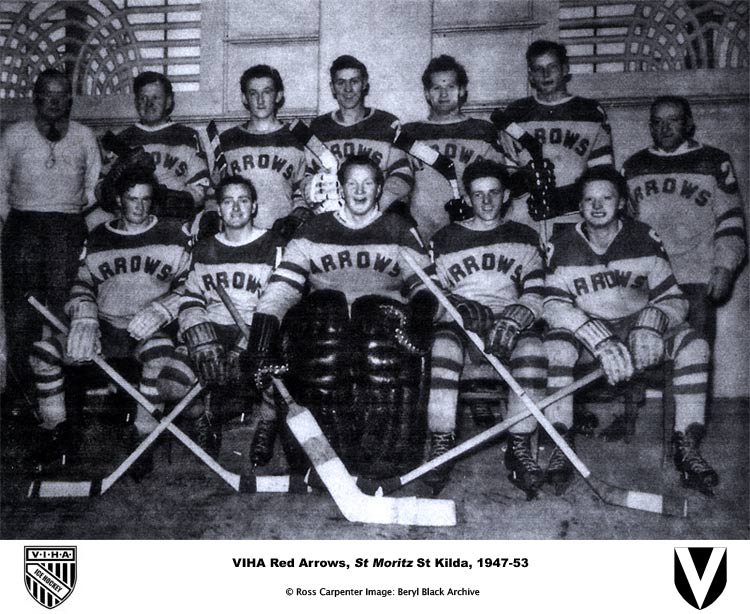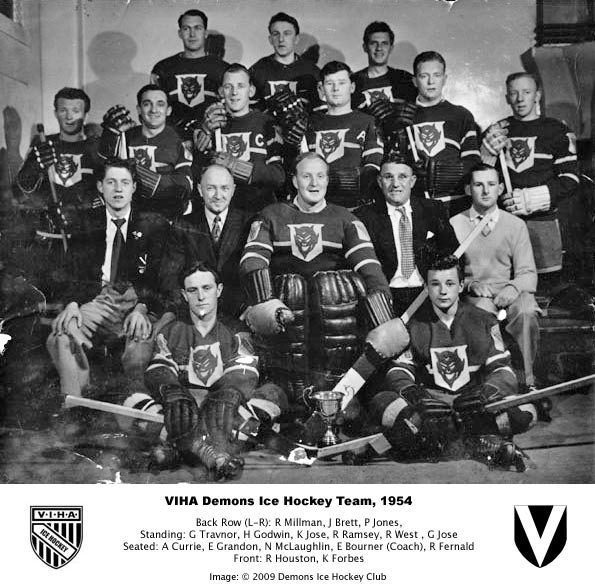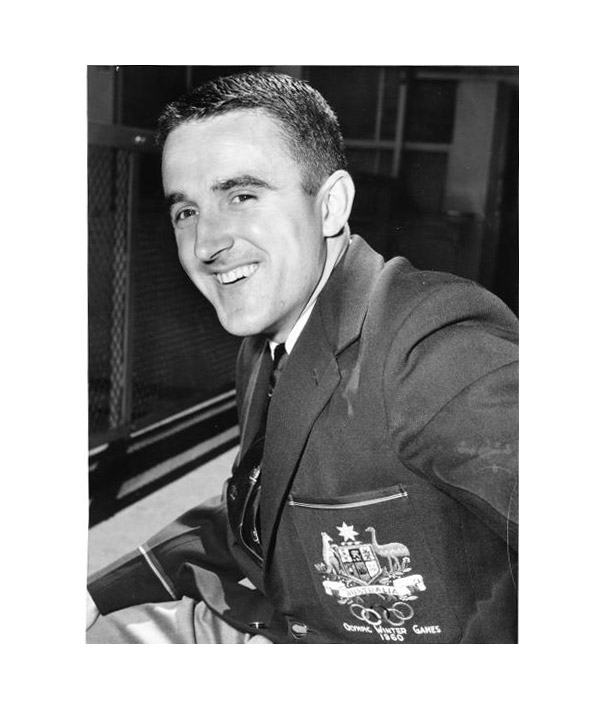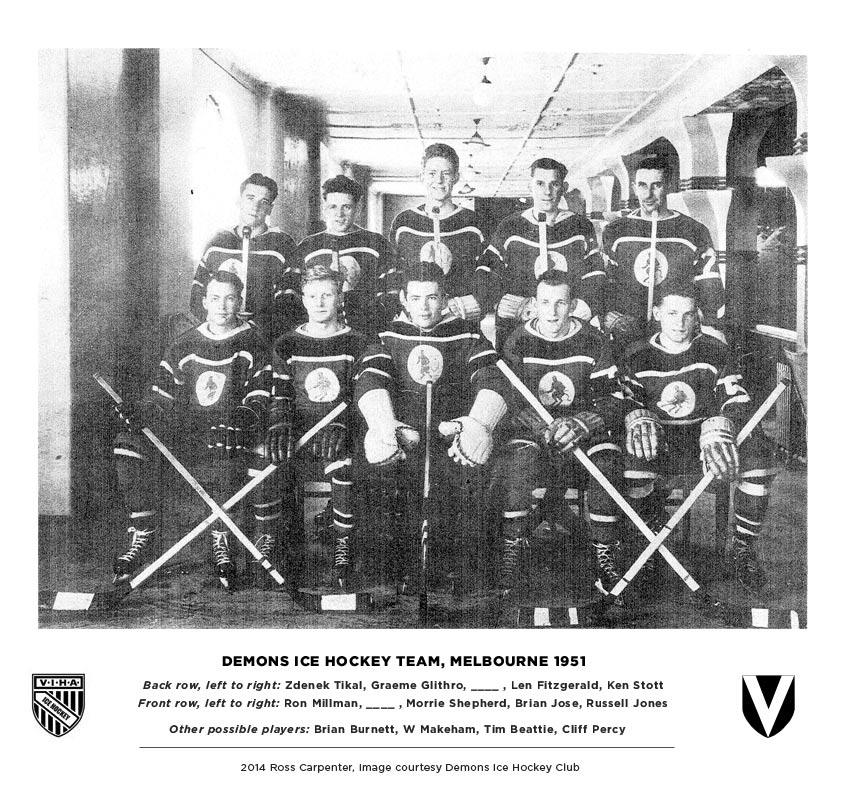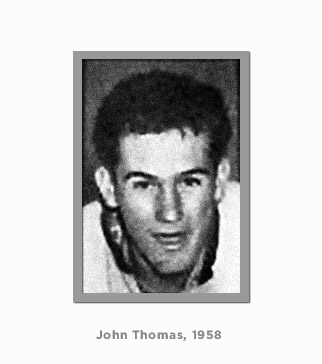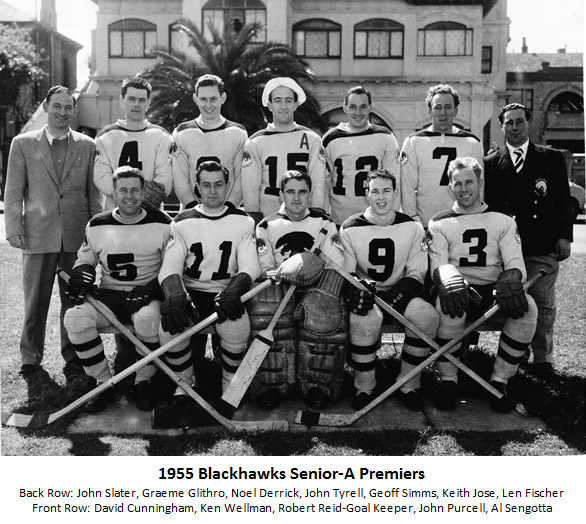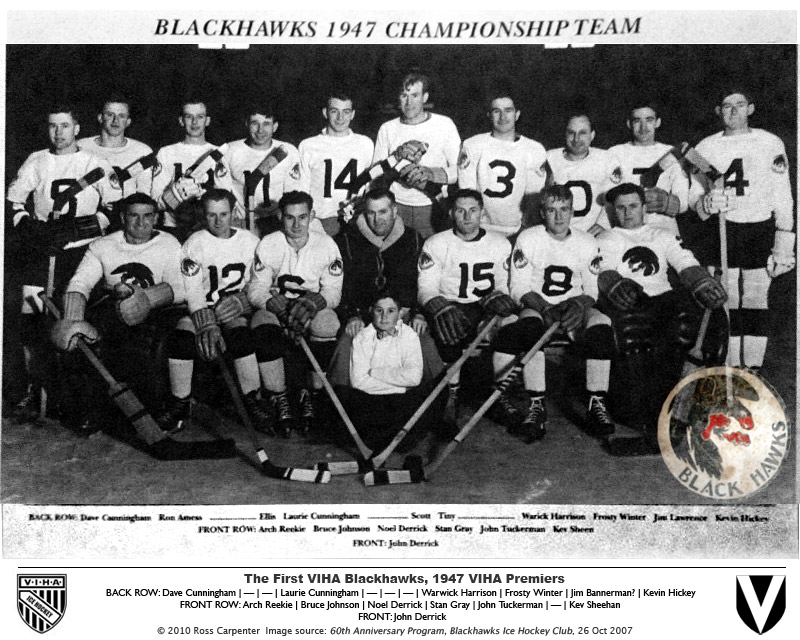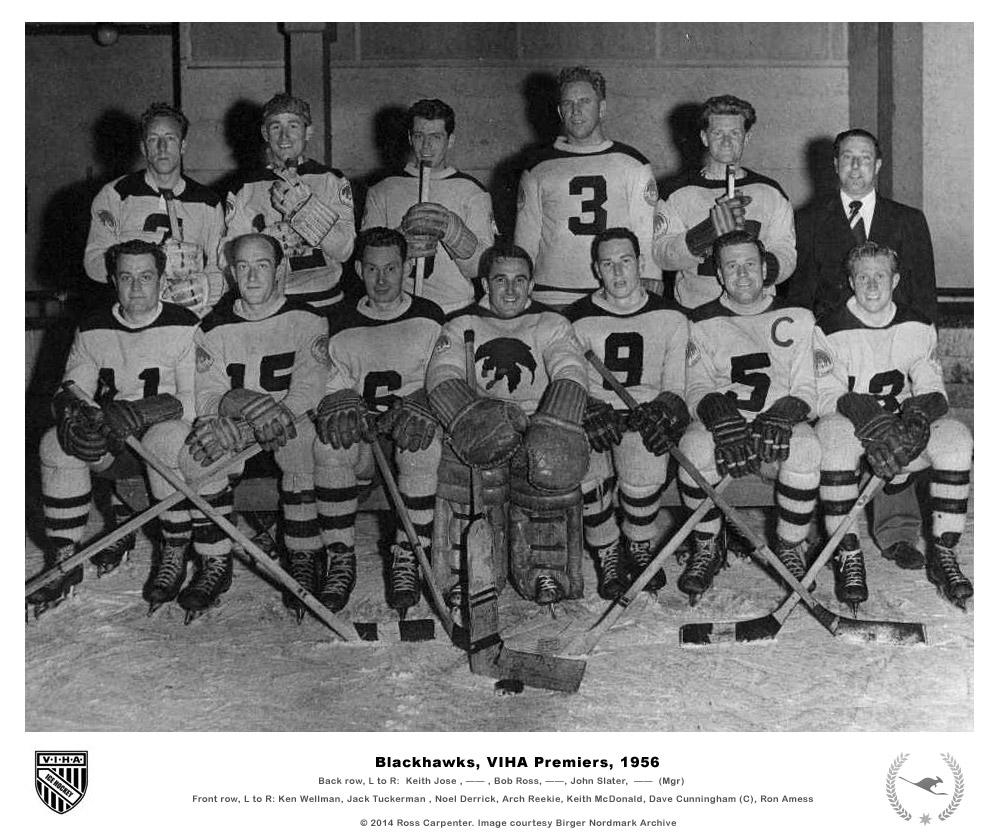Legends
home
1936 1st AUSTRALIAN Winter Olympian
1947 1st International Figure Skating GOLD Medallist
1960 1st Australian Olympic and World Championship ICE HOCKEY Teams Squaw Valley California USA
1961-2 2nd AUSTRALIAN Ice Hockey World Championship Ice Hockey Team Colorado USA
1963-4 2nd OLYMPIC Qualification ICE HOCKEY Team Tokyo Japan
1987 1st International Ice Hockey MEDAL Perth Australia
2008 Ice hockey World Championship PROMOTION TO DIVISION I Newcastle Australia
James Archibald BROWN (Jimmy)
(1908 - 1959)
JIMMY BROWN WAS BORN March 31st, 1908, at Falkirk, in the Scottish midlands [29] to parents Jessie Naesmith and Francis Cowan "Buster" Brown (1872–1936). [27] His father, Frank, was born in Glasgow city to parents John Thomas Brown and Charlotte Augusta Cowan who had married on June 29th, 1863 at Milton, Glasgow. [28] Jimmy emigrated to Australia with his family when he was about 8 years-old. Frank became an executive of Metter's Ltd, which Frederick Metters had established in Sydney in 1902. Frank was also the donor of the first of three Australian ice hockey trophies bearing his family name (notes below). Jimmy's mother, Jessie, and brother John Thomas Brown (bef 1907–1953), were both keen skaters. John, the elder, was a figure skater of note, New South Wales ice dancing champion, National dance champion in 1939 with N Conner representing New South Wales, and later president of the New South Wales and national ice skating associations (now Ice Skating Australia).
Brown joined the NSW Eastern Suburbs IHC at age twelve, home club of Jim Kendall by whom he was coached, and graduated to A-grade hockey two years later. Like Kendall, Brown was a defenseman. He was a foundation member of the St George IHC in 1928, eventually becoming captain. St George was one of the most successful New South Wales clubs in Australian hockey history (images below), winning the State Premiership seven times during its first decade. St George also played the highly controversial match against the pro Canadian Bears at Sydney Ice Palais in 1938. The aftermath of this game and subsequent press coverage led to a break-away group being formed by the Ice Palais management, posing the first threat to Australian controlling bodies (see Tom Coulter). In 1949, St George presented the New South Wales ice hockey association with the Les 'Snowy' Reid Memorial Trophy for interteam speed skating, when Brown was still a manager and coach (see Leslie Reid).
Although some official records say Brown commenced Interstate competition from the mid-1930s, he played his first Goodall Cup series on record in 1927 at the age of 21, and became a regular member of Interstate ice hockey teams representing New South Wales until 1946. He won the New South Wales speed skating championships on many occasions. He was five times Australian quarter- and half-mile champion, and on his way to establishing new speed records. He visited Great Britain in 1930 where he won the British quarter- and half-mile speed skating championships and represented Britain in the international games at Davos, Switzerland (probably the 1929 European Championships). The Argus newspaper in Melbourne reported:
"... British Champion's Return. The ice-skating one-mile championship of Great Britain was won recently by James Brown of Sydney, who covered the distance in 3min 26 1-5sec. Subsequently, in a speed test, he broke the British record, skating a mile in 3min 6sec. He is returning to Australia on RMS Orsova and will give an exhibition at the Glaciarium on Monday evening, when he will attempt to break his own ice skating record for one mile". [229] Brown won by one-fifth of a second, as reported by the Canberra Times, "... J Brown, the Australian ice-skating champion, won the mile indoor skating championship of Britain by defeating the holder, W Broomhall, by one-fifth of a second in 3 minutes 26 1-5 seconds." [229]
A Sydney newspaper reported Brown appeared to deterioate after he peaked in 1930. He sprinted 440 yards in 44-1-5 secs in Melbourne that year. In 1932 he was diagnosed with advanced appendicitus that escalated to peritonitus. He had four major operations that "were matters of life or death" and it appeared his skating career was over. Then in August 1935, he dead-heated Pat Jackson skating 440 yards in 47 3-5 secs — 2-5 secs faster than Ken Kennedy had done the previous year — and went on to win the 1935 Australian half-mile championship by 10 yards from Jackson and Ellis Kelly, in 1min 38 1-5 sec. He attributed his comeback to the training and encouragment of Tommy Meagher OBE, a former captain of Bondi Surf Club. [469]
Jim Brown was one of the few skaters of his era to pass the National Ice Skating Association (NISA) Gold Medal Test; the most demanding benchmark of ice skating proficiency at the time. These Bronze, Silver and Gold level tests were first set up in 1880, when the NISA broadened its scope to include figures as well as speed skating. They were developed by H E Vandervell, "The Father of British Skating", and co-author of the 1869 treatise, A System of Figure Skating. Spectators and officials alike were astonished that a skater from a non-skating country possessed such proficiency, and Brown was often referred to as "Flying Jim Brown, the Meteor".
While in England, Brown also played hockey for the newly formed Grosvenor House Canadians (1930–1 season) at London's Park Lane ice rink; one of the few non-Canadians on the team. This was the very beginning of the pro era in Britain and this team was the first British ice hockey team known to be paid. The Canadians were founded a year earlier in 1929 by F L 'Freddie' Summerhayes and played in the English League 1931-4, changing to Wembley Canadians for the 1934-5 season, and its successor Wembley Monarchs in 1936. Their home ice was Park Lane Rink at Mayfair, London, which opened in 1927 in the basement of Grosvenor House Hotel, then at Empire Pool, London from 1934, now known as Wembley Arena. The Canadians were the English League Champions in 1933-4. Brown also played several challenge games for Great Britain, representing England, Scotland and Great Britain against Canada, France, Germany and Switzerland; the only Australian to do so. [427]
Brown returned to Australia in July 1931 and continued with St George in various roles until 1950. He was captain for a record eighth time in 1937 and also head coach. [427] The club even changed their colours to the grey, red and white of Grosvenor House Canadians. [473] There were few in the Victorian ice hockey team who could match Brown's speed. When he returned from England, The Argus newspaper in Melbourne reported, "... [Victorian, Ellis] Kelly, who recently won the quarter and half mile championships, will be a strong opponent for Brown, the New South Wales champion, who has also won titles in England and Switzerland." [229] Brown skated faster than Ellis Kelly and then went on to break his own speed record that same year. This pair were among the first and fastest skaters to emerge from the combined federation of ice hockey and speed skating in 1923, when Australian ice hockey entered its demon decade (see Ted Molony). Yet speed skating had declined in Sydney from the time Leslie Reid died and Harold Hoban was association president. Brown and St George were behind the push in 1937 to reinstate regular speed skating handicaps with Hoban's approval. [473]
In 1936 at Sydney, Jimmy Brown married Gwendoline Myrtle Fraser, daughter of James and Isaline Alma Fraser. [27] From 1938, he was captain of Sydney Glaciarium Ice Hockey team in the inter-rink compettion with the Ice Palais team during the war years. He enlisted in the RAAF at Sydney in 1940, where he served as a Sergeant with the 11th Squadron during World War II at RAAF Base Richmond, north-west of Sydney. [27a] His squadron deployed to Port Moresby in New Guinea where it monitored Japanese shipping movements in the region, flew patrol missions across the South West Pacific area, and carried out offensive mine-laying operations until the end of the war. Brown's brother, John, may have served as a squadron leader in the RAAF during the war.
In 1938, Brown publicly condemned criticism of the standard of British and Australian ice hockey by Ken Tory, a professional player from Canada. "Australian ice hockey can't be compared with the professional leagues in Canada and America", he said "for they have the pick of the best players in the world. But Australia ranks very high in world company in amateur ice hockey. In fact, only 4 or 5 countries would be likely to beat Australia, even as she is at present with no international experience. Canada, USA, Great Britain and Germany would probably be too strong for Australia, but countries such as Sweden, Norway, Poland, France, etc are not above the Australian standards". [470]
Eighty-five years on, all four countries rank higher than Australia and Sweden was the top seed in 2013. A month earlier, Tory had represented New South Wales in the 1938 Goodall Cup with fellow Canadian, George Balork. Hall-of-Famer Hap Holmes had also accompanied the New South Wales squad on that trip to Melbourne, "to gain knowledge of the standard of play, with the object of possibly returning next season with two professional American teams". [471] Holmes was manager of the Cleveland arena at the time, and a few months earlier he had told the press the standard of Australia's ice hockey was very high [470] and it seemed to him Australians would like the game:"I have come here partly on holiday and partly to see whether this game would be popular." [471] Nothing came of it, but New South Wales did manage to hold onto the Cup for two more seasons.
Jim Brown presented the F C Brown Memorial Shield, the second of the three Brown trophies, for the second Interstate series in 1938, in memory of his father. He represented New South Wales in the Goodall Cup until 1946, often as captain, then became a manager and coach with the New South Wales Ice Hockey Association. Although he retired as a player at the age of 39, he continued in the sport as a selector and coach for New South Wales. He was also a keen surfer and former member of the Cronulla Surf Life Saving Club, founded in 1907. Brown was the first Australian ice hockey player and speed skater to compete overseas, preceding Ken Kennedy by five years. He was made an Honoured Life Member of Ice Hockey NSW in 1951, and died at age 51 at Sydney in 1959. His wife Gwen died twenty-one years later in 1972, at St Leonards on Sydney's North Shore. [27] In 1964, Harry Curtis, president of the NSW Ice Hockey Association, donated the Jim Brown Shield to perpetuate the memory of an Australian ice hockey and speed skating legend. Today, the Jim Brown Shield is presented annually as the Brown Trophy to winners of the IHA under-20 national ice hockey championship.
Notes:
[1] There have been three trophies bearing this family's name in the history of Australian ice. The first was presented by Francis Cowan "Buster" Brown in 1932 for interstate relay speed skating between members of the Goodall Cup Interstate ice hockey teams. Each competitor skated two laps. Cast in the USA and very valuable, it became known as Gloria because of its statuesque design. The Trophy was the only perpetual trophy for Speed Skating until 1951 when it was discontinued. Its whereabouts is unknown.
[2] The second, the F C Brown Memorial Shield, was presented by Jim Brown in memory of his father for the second Interstate series in 1938. His father, son of John Thomas Brown and Charlotte Augusta Cowan of Milton, Glasgow, Scotland, died two years earlier in 1936 at Petersham, NSW. [27, 28] This Brown tournament was always referred to as the return Interstate Ice Hockey series, played yearly in either Victoria or NSW — wherever the Goodall Cup tournament was not. It was not a Junior Competition; rather it gave players on the fringe of Goodall selection an opportunity to demonstrate their ability, although Goodall Cup players formed the nucleus of the tournament's teams. Its whereabouts is also unknown.
[3] The third, the Jim Brown Shield, was donated in 1964 for Interstate junior ice hockey by Harry Curtis, president of the NSW Ice Hockey Association. It was intended to perpetuate the memory of an Australian ice hockey and speed skating legend. Curtis was an executive with Lever Bros (now Unilever) and played for Glebe IHC (later known as Glebe Winfield Lions that merged to Canterbury United IHC and became Canterbury Eagles IHC in 1986). He had competed against Jim Brown on many occasions. Today, the Jim Brown Shield is presented as the Brown Trophy to winners of the Australian Under 20 ice hockey championship, but in earlier years it had been presented to the Senior B Australian Championship winner (Reserve Goodall). Prior to that, it was presented to the winners of the 'return' Interstate series — either Victoria or NSW — whichever was not hosting the Goodall tournament, and always in a different month to it.
Sidney Robert CROLL
(1912 - aft 1977)
SPORTS BIOGRAPHY IN FIGURES CHAMPIONS. SYDNEY CROLL WAS BORN on February 12th, 1912 in Sydney. He was a hockey player and speed skater in his youth, but his major influence was in the world of figure skating, and he went on to become a World and Olympic judge with the International Skating Union. Croll owned Australian Ice Sports Limited which leased Prince Alfred Park ice rink in Sydney, 1968 – 70.
![]() Master Sidney Croll | 1923 |
Master Sidney Croll | 1923 |
Kenneth George KENNEDY
(1913 - 1985)
KEN KENNEDY WAS BORN September 6th, 1913 in the family bootshop in Sydney, New South Wales. He was the son of John (Jack) 'Pop' Kennedy (bef 1895–aft 1949), vice-president of the NSW Ice Hockey Association. Jack Kennedy was a surgical bootmaker who, like Ted Molony in Melbourne, made figure skating boots at his premises at 520 Kent Street, Sydney. He lodged an application in Canberra for registration of an ice hockey boot design in 1930. [62] Kennedy was a speed skater and ice hockey player with one of the highest profiles ever in Australian winter sports. He was a 13 year-old schoolboy and bootmaker when he became a trainee cadet with the Australian Military Forces on July 18th, 1927. He lived with his father at Edwin Street in Tempe, a suburb in the inner west of Sydney, and later at 71 Liverpool Street in Sydney. [62]
Kennedy started his active ice hockey career in 1928 with Sydney's Eastern Suburbs IHC, which Canadian expat Jim Kendall founded and captained. Coached by Kendall, he debuted as a 17 year-old just three seasons later in the 1931 Goodall Cup. He represented New South Wales in the interstate series held in Melbourne the following year, with captain Merv Jackson, Canadian Percy Wendt (1912–1995) and Widdy Johnston. [1] This 1932 series resulted in a tie, NSW 6–0, 1–1, 0–2; the first Goodall Cup draw after nine successive championship wins by New South Wales (see Ted Molony). Kennedy was the Australian quarter-mile and one-mile champion speed skater from 1931 through to 1934. His personal bests were 500m: 47.4 (1936); 1,500: 2:31.8 (1936); 5,000: 9:48.9 (1936) (see Racing Champions for full Olympic results).
Kennedy travelled overseas for more specialised training and competition, leaving Australia in December 1934 for England. He first raced in the British Indoor Speed Skating Championships in which Jimmy Brown had earlier competed, winning the half-mile and one-mile titles and establishing new record times in 1935 and 1936. He won the 1935 one-mile British title in 3m 7s. [448] That success culminated in his selection at age 22 as the first Australian Winter Olympian and the sole member of the first Australian Winter Olympic team in 1936, competing in the 500m, 1,500m and 5,000m long track events in the twin Bavarian towns of Garmisch-Partenkirchen, Germany. At that time, International speed skating was contested under Long Track rules which required a very different technique to the Short Track Kennedy was used to. All Olympic skating sports at the time were contested on outdoor, naturally-frozen ice with much lower air temperatures, and surfaces that were less smooth, than the indoor rinks on which Kennedy had trained. There were 52 competitors at the 1936 Games, and his best results were 29th in the 500 metres, 33rd in the 1,500 metres, and 33rd in the 5,000 metres. [37]
Although Kennedy was the only member of the Australian team, his entry received official backing from the Australian Olympic Federation, who said: For the first time in Olympic history Australia will be represented at the Winter section of the Olympic Games. The Executive Committee has carefully considered and endorsed the entry of Kenneth G. Kennedy to represent in the Ice Speed Skating events. The NSW Olympic Council reported: Kennedy ... has the honour of being the first representative chosen for the winter section of the Olympic Games ... [He] amply justified his nomination. Kennedy himself said of the games in Nazi Germany: They were magnificent, well staged and closely policed by the army. Wherever you went there were guards ... the army. They did not interfere but you knew they were there to keep order and to make doubly sure nothing went wrong for the Fuhrer. [22]
Kennedy was unable to defend his British one-mile speed skating title in 1936 because the Olympics was scheduled at the same time. But, in 1937, he won the title back in 3m 13s at Harringay Arena. [448] While in England, Kennedy learned a trade with a Birmingham jeweller and played Division I hockey in the English League between 1934–37 for Warwickshire IHC, Worcester IHC, then back to Warwickshire for a season, renamed Birmingham Maple Leafs IHC. This was a few years after Jimmy Brown played for England's Wembley Canadians. Cliff Thaell was head skating instructor at the Birmingham rink during those years. He then held the same post at Sydney Glaciarium from 1936. [466] The Birmingham club was part of the biggest amateur league in the world and won the English League Championship (1935-6 season). Great Britain had competed in international ice hockey since 1910, including the victorious 1936 Olympic Games campaign where it captured the Triple Crown of World, Olympic and European ice hockey titles. Kennedy had represented Australia in speed skating at the same Olympics, while he was living in England and playing hockey.
When hockey in Birmingham was abandoned, he turned to professional skating, by joining the traveling troupe of Australian professional pair-skaters, Enders & Cambridge. [430] He earned £75 per week at a time in England when "the basic wage was 50 bob" (about £2.5). He featured in ice shows and did barrel jumping and, although it does not figure in official histories, he won the British Amateur indoor mile ice skating championship again on Harringay Rink, on March 10th, 1937, thus retaining the title which he had held since 1935. [171] He served in the Royal Air Force throughout the war and returned to Australia in 1946.
Back home, Kennedy renewed his involvement with speed skating and ice hockey. He won further speed titles and represented New South Wales in ice hockey from 1947, until his retirement in 1953 at the age of forty. In 1950, the Victorian Ice Hockey Association was admitted to the Olympic Federation and long-range plans were discussed regarding the possibility of a touring Australian team (see Harold Luxton). The Ice Hockey and Speed Skating Council of Australia (IHSSCA), formed in 1923 with John Goodall as founding president, was renamed the Australian Ice Hockey Federation (AIHF) in 1952, with Kennedy as president until 1964. Kennedy was also the AIHF delegate to the Australian Olympic Federation, where he argued that overseas trips would be needed for Australia to reach world standard. He was succeeded by John Purcell, from 1976 until 1980, defenseman for Australia in the 1962 ice hockey World Championships and IHV Life Member; Phillip Raleigh Ginsberg OAM (1923–98) from 1981 until his death in 1998; and now Don Rurak.
Kennedy's post-Olympic contribution to speed skating and ice hockey was life-long. In the 1980s, he still skated and owned an ice skating equipment shop, Kennedy's Skate Shop, near the former Glaciarium and Central Railway Station. He ran this family business into his seventies, serving the personal skate requirements of many Australian skaters. During Kennedy's term of office as president of both the New South Wales and National ice hockey associations, Australia sent its first ice hockey team to the 1960 Winter Olympics, and to the World Ice Hockey Championships in 1962. Kennedy was made a life Member of the NSW Ice Hockey Association in 1954 and the National Association in 1964. He died at age 72 on August 20th, 1985. He was the first inductee to the Australian Ice Racing (AIR) Roll of Honour and inducted as an athlete to the Sport Australia Hall of Fame on December 9th, 1986 for speed skating. To date, no ice hockey athletes have been inducted.
![]() News articles | 1935 | 1936 | 1938 |
News articles | 1935 | 1936 | 1938 |
Historical notes:
[1] In 1978, ISU arranged their first short-track championships and it is no longer necessary to spend months and fortunes to compete in championships on the other side of the globe. Yet this also signalled the demise of Australian long track speed skating. Australians have not competed in long track championships since 1994. The only "long track" in existence in Australia was a highland lake near Mt Buffalo, Victoria, which had been used by skaters for training since the 1940s when conditions permitted. But skating on it was prohibited when Eddie Spicer drowned there in 1997. [58]
[2] Australia's Winter Olympic success has occurred in recent times. The first Winter Olympic medal was won at the Lillehammer 1994 Winter Olympic Games with a Bronze medal in the 5000m Relay (Richard Nizelski, Kieran Hansen, Andrew Murtha and Steven Bradbury). Australia's first Winter Olympic Gold medal was won at the Salt Lake 2002 Winter Olympic Games by speed skater, Steven Bradbury. As a result, Australian speed skating is now well-supported by government and sends teams to ISU World Cup events each season. Ice sports produced the first two Australian Olympic winter sports medals, and four others have since been won by freestyle and alpine skiers.
[3] Kurt De Fris AM (bef. 1947–1983) was the first recipient of an Australian Honour for ice sports, and the first Life Member of Ice Hockey Victoria. The son of Gisela and Sigmund De Fris (bef. 1865–1946), his father immigrated to Melbourne on John Elder in 1883. He was made a Member of the Order of Australia on June 7th, 1976, when he lived in the Melbourne suburb of Balaclava. Kurt died on March 28th, 1983 and was buried at Springvale Botanical Cemetery, Clayton, Victoria, with Lorraine De Fris (1947–1990) (SBC Jewish Memorial Lawn Grave 2 P 39). The IHA Kurt De Fris Memorial Trophy is named in his honour and presented annually to the National Junior Under-15 Champions. Phillip Raleigh Ginsberg OAM (1923–98), IHA Life Member, was the second recipient of an Australian Honour for ice sports. Born October 2nd, 1923 at Wellington, New Zealand, [60] his Medal of the Order of Australia was conferred on June 10th, 1985 at Mosman, NSW 'for service to the sport of ice hockey'. The IHA Ginsberg Memorial Trophy is named in his honour and presented annually to the National Junior Under 13 Champions.
[4] Don Rurak was awarded the Australian Sports Medal in 2000, the year nominations were first called, 'for your many years service to Australian ice hockey'. Some other ice hockey recipients in the short history of the Australian Sports Medal are: John McCrae-Williamson (1916– ) who was born at Carnegie, Victoria [29, 60] for "AIHF life member" in 2000. The IHA McCrae-Williamson Trophy is named in his honour and presented annually to the National Junior Under 11 Champions. Sydney Edward Tange (1917–2005) "AIHF life member NSWIHA life member and past AIHF president". The IHA Tange Trophy is named in his honour and presented annually to the National Junior Under 18 Champions. Charles Grandy "AIHF life member and past AIHF vice-president and treasurer". [56] Alan Frank Robinson whose citation reads: 'Has competed in NSW, Australian and International competitions dedicated to Ice Hockey'. Szabolcs Majsay "NSWIHA life member AIHF treasurer - 26 years". Norm McLeod, IHA Life Member and Secretary, 'for your long standing service to Australian Ice Hockey'. McLeod played with Sydney's Prague Bombers in 1959, first as a defenceman and then as a goaltender. He was a member of the NSW Brown Trophy Team in 1963 and 1972. He has officiated since 1964 and he was a player-coach in 1964 and 1974. Selected for Australia's National Team for the World Championships in Grenoble, France, but withdrew due to family reasons.
[5] Birmingham Maple Leafs' 1935-38 home ice was Birmingham Ice Skating Rink, Summerhill Rd, Birmingham, England. It opened in 1931 and was purchased by Silver Blades (part of the Mecca organisation) in the early 1960s and known as the Mecca Ice Rink. It had a seating capacity of 1,500 people and the ice pad was 190 feet by 80 feet, and closed in 1964. Mecca also owned Streatham Ice Rink, London, among others. The Birmingham Mohawks Ice Racing Club was formed on December 1st, 1935, the year after Kennedy arrived. It was affiliated to the National Skating Association of Great Britain.
Thomas Henry COULTER
(1911 - 2003)
BORN APRIL 21ST, 1911 at Winnipeg, Manitoba, Canada, Tom Coulter was youngest of three boys. Victorian-born Tommy Dunderdale and his family lived in Winnipeg during most of Coulter's sporting career, a star player with Charles Uksila in Portland Rosebuds, the forerunner of the NHL Blackhawks in which the Coulter brothers later played. Although a "one-gamer", Coulter was the first NHL player (1933–38) to play in Australia and an accredited referee. Brother of Arthur Edmond "Art" Coulter (1909–2002), NHL defenseman, 1925–43, who played minor hockey in Winnipeg with the senior Pilgrim club, in the Manitoba Junior Hockey League, and left the city in 1927 after one season as a junior. As a boy, Tom skated on any frozen surface he could find in Winnipeg, and first played organized hockey in high school, winning the Senior School Series Hockey Championship with St Johns College in 1927. Oldest brother, David, won titles in amateur boxing and wrestling and was runner-up in the 1928 Olympic heavyweight boxing. David moved to Pittsburgh and soon convinced his father to move the family automotive and hardware business there. Art turned pro in 1929, gaining two and a half years experience with Philadelphia Arrows in the Can-Am League, then entered the NHL with Chicago Blackhawks in 1931–32. Tom completed high-school at Pittsburgh and then attended Carnegie Tech. He played halfback for the football team and was captain of the track and field team. He set several records and had the 29th best time in the world in 1931. He returned to Manitoba in 1932 to compete in the Canadian Championships, where he won the 440m hurdle event, and a spot on the 1932 Canadian Olympic Team that competed in Los Angeles. He was automatically disqualified after he knocked down four hurdles.
Coulter completed a degree in engineering graduating from Carnegie Mellon University in 1933. A mentor suggested the University of Chicago's business program. But he was faced with the problem of paying for his tuition during the Great Depression, with little prospect of finding a job that would both pay well and permit time for studies. His brother Art was about to begin his third season (1933–4) with the Blackhawks, and he suggested Tom pay his way by also playing for them. He had not played organized hockey since Winnipeg almost ten years earlier, apart from some pickup hockey at Carnegie Tech. A tryout was arranged and he was offered and signed a $2,500 contract. He played one game with the Blackhawks in the 1933-4 season before the coach decided a year in the minors would fine-tune his abilities, making him a shoe-in the following season. He played the rest of the 1933–4 season with the AHA Oklahoma City Warriors, appearing in 47 games and managing two goals, one assist and thirty penalty minutes. He returned to the Blackhawks at a training camp, where he played along side his brother in defense. He had been injured and sidelined for at least six weeks when the Hawks traded him to the IHL Cleveland Falcons. He decided to hang up his skates after a lackluster six games dealing with a leg that just wasn't what it used to be, but he had also met Mary Alice on campus. She became his wife in 1937 and lifelong partner. He completed his Master’s Degree in Economics in 1935 then accepted a job with a large US company named Armco, developing and manufacturing Zonolite insulation.
Coulter lived overseas for several years overseeing construction of manufacturing plants in Australia, Burma (now Myanmar) and India. While in Australia, he decided to strap on the blades once again for NSW St George IHC. However, it is unlikely Coulter's appearance in Australian amateur hockey was incidental. He was probably connected through Tommy Dunderdale to Jimmy Bendrodt in Sydney, preceded by earlier arrangements in which Bendrodt was involved, such as the Uksilas season in Melbourne in 1923 with Robert Jackson (also see Tommy Dunderdale). It was apparently common in those days for Canadians living abroad who played organized hockey to skate circles around the locals and intimidate opponents with physical play, and Coulter didn't disappoint. He was 6 foot 2 inches tall (188 cm) weighing 210 pounds (95.3 kg) and his rough play caused a fuss between opposing teams. The much awaited clash between the Bears and St George was held on September 14th, 1938. The Sun newspaper said the following day:
"For 40 minutes last nights hockey giants flashed and skidded in the fastest and most thrilling game for years. Play was rough but never out of control of referee Norm Turner whose quick decisions and refusal to tolerate infringements kept the players in check. Tom Coulter was penalized five times. 'Spike' Robinson (note 1) was knocked out three times but recovered to score the winning goal. The aftermath of this game and subsequent press coverage led to a break-away group being formed by the Ice Palais management posing the first threat to Australian controlling bodies. Perhaps the whole episode would have petered out but for a letter sent sent by the Ice Palais management to the captain of St George, Jim Brown. It inferred that Tom Coulter of St George was a 'dirty' player. Tom Coulter was on a business trip to Australia. His brother Art Coulter played for the Chicago Black Hawks and was considered one of the best defensemen in the NHL. Tom Coulter had also played with the Black Hawks and was also an accredited referee. Today, he would still be considered the best hockey player in Australia." [The Sun, Sydney, 15 Sep 1938]
The referee, Norm Turner, was probably N L Turner who had represented New South Wales in the Goodall Cup during the Kendall-Reid-Pike era and later. Dunbar Poole was manager of the Ice Palais when this match took place (note 2 below). Coulter played for other teams while in Australia, before finishing his work there and moving to Rangoon, Burma, to oversee another construction in 1939. He later settled in Chicago where he and Mary raised their four children. He was CEO of the Chicago Chamber of Commerce for more than twenty-five years, 1954 to 1981, once again traveling locally and abroad to promote Chicago. He organized six major international trade fairs in the city during the 1950s and 1960s that he promoted around the world. Coulter’s vision for Chicago as a worldwide center for trade earned him decorations from the Governments of Great Britain, Germany, Italy, France, Austria, Finland, Sweden and Japan. [1, 43] He was Director of the Chicago Tokyo bank for many years; and president of both the Executives Club of Chicago (1948-53) and the Sales and Marketing Executives Club of Chicago (1948-56).
![]() Sydney Ice Palais | 1938 | Pirates vs Hakoah, St Moritz | late-1960s |
Sydney Ice Palais | 1938 | Pirates vs Hakoah, St Moritz | late-1960s |
Notes:
[1] Spike Robinson was Don "Spike" Robertson who played for the Kenora Thistles from 1935 (also see notes for Russell Carson entry).
[2] Sometime after 2002, a copy of the Sun newspaper report of the Bears vs St George clash (above) was published at hockey.com, a not-for-profit research project. It was probably the source for part of the Society for International Research (SIHR) entry on Australian hockey. The SIHR paraphrased half the original newspaper article, but in a reversal of fact: "The captain of St George Club, Jim Brown (Ex-Grosvenor House Canadians) sent a letter in the name of the Ice Palais management and inferred that player Tom Coulter of St. George was a 'dirty' player." The original clearly states the Ice Palais management wrote to Brown, captain of St George, "inferring" his player Coulter was "dirty". This served to escalate this 1938 contoversy and its subsequent press coverage. Jimmy Bendrodt, owner of the Ice Palais, had brought the Bears pro team from Canada for the express purpose of promoting the sport and his newly opened rink. He also brought Dunbar Poole back from retirement to manage the rink when he was in his sixties. Within months, Poole was central to events which led to the first direct confrontation with the Australian controlling authorities, and the formation of a break-away group. It had all stemmed from the controlling authorities decision to prohbit the professional Canadian Bears team from competing in the amateur Australian leagues (see Russ Carson). It found new impetus when St George played a former NHL one-gamer in this off-season match.
Frank CHASE
(abt 1912 - 1975)
CHASE WAS BORN IN OTTAWA, Ontario, Canada but moved to London to play in the British National League (BNL). It was from there that he was hired by the owner-manager of St Moritz ice rink, Harry Kleiner, to be his rink coach shortly after the Second World War. Kleiner wanted to boost VIHA hockey in the years it was feuding with the rival VIHL. [558] Chase was once described as an "Ottawa hockey stalwart" by the Ottawa Citizen newspaper. [424] He was a pro hockey player who competed in five countries, including left wing for Wembley Canadians in the BNL/ ENL [40] in 1935-6. That was four years after Australia's Jimmy Brown played for their predecessor, Grosvenor House Canadians. Chase played for the Dutch National club in Amsterdam the following year (probably today's Amstel Tijgers), and then later in Germany. He helped build and manage several rinks in Scotland during the Winter of 1937, and refereed there in 1939. He joined the Toronto Scottish Regiment at the onset of war in 1940, which was based in London. [424]
Chase returned home to Ottawa after the war, but only briefly. Hockey in Scotland had become big business in his absence with 70 Canadians imported to play semi-pro in the national league. A Toronto sports journalist, Claude Kewley, was the Canadian scout of the Scottish Ice Hockey Association. He recruited for Scotland from summer camps such as the one he organised in Toronto in July 1947. [424] Ice Hockey Journalists UK credit Kewley with selecting the line-ups of the seven teams of the Scottish National League until 1949. It is worth noting the similarities between British hockey then and today's Australian Ice Hockey League. Both provided hockey players in Canada with the opportunity to extend their careers by a few years playing at a semi-pro level.
Chase discussed hockey with Festus Moffat, the president of the Scottish Ice Rinks Association, at a meeting of the Canadian Amateur Hockey Association (CAHA) in Quebec early in 1947. He arranged with Moffat to return to Scotland in August that year to coach and manage the Ayr Raiders in the first Scottish Hockey League (1932-1954). [424] The Raiders were established in 1939, and they went on to become SHL champions in 1954 and 1955, but without Chase. The League then merged with the ENL and the Ayr franchise subsequently changed its name to Ayr Rangers and Ayr Bruins.
Chase reportedly trained the Victorian team that won back the Goodall Cup in 1947 after a quarter century in the wilderness. He may also have coached the Ayr Raiders as arranged in Quebec early in 1947 by returning there in the off-season. He is pictured in Australian newspaper articles in January 1948 [425] and July 1949 returning from Toronto. [426] He started an off-season school at Kleiner's St Moritz rink for aspiring young players in the summer of 1949-50. It produced several talented players including Vic Ekberg who went on to coach the Tigers. [558] Chase was Manager–Coach of Victoria in 1949 and 1951 when they won the Goodall Cup, and in 1950 when they lost. Chase also became the second Senior Coach of the VIHA Demons IHC after Russell Jones for three seasons, 1950–2. Francis Thomas Chase died in Melbourne about August 1st, 1975. [51]
Russell William CARSON (Doc)
(1915 - 1996)
DOC CARSON WAS BORN January 30th, 1915 in Kenora, Ontario, Canada. [45, 47] He was a goaltender whose Australian playing career spanned from 1938 to 1947, and possibly included Kenora Thistles. He arrived in Sydney, Australia in 1938 at age 23 when Jimmy Bendrodt (1891–1973), who had earlier managed the Sydney Glaciarium, brought an ice hockey team from Kenora, Ontario for the opening of his Ice Skating Palais. Bendrodt had converted the former Palais Royale theatre for the ice rink, and he shamelessly valued the publicity potential of the rugged incidents that often arose with Canadian hockey imports. The team is referred to in local literature as 'Canadian Bears', or Kenora Bears. In 1936-7, Carson played with the Clayton Flyers of the Manitoba Amateur Hockey Association, then the Toronto Posties in 1937-8, before returning to the Flyers. He had played Allan Cup elimination games in the Manitoba-Thunder Bay district. [40, 575].
Bendrodt promoted the visitors as an amateur team but the NSW Association prohibited them from playing in Australia's amateur leagues because they considered them professionals. The Canadian Bears did not play an Australian team until the end of the 1938 season and, even then, they were all suspended by an irrate Association. However, their suspensions were in weeks not matches, and so they expired long before the next winter, when St Moritz ice rink in Melbourne also opened, and the focus of Australian hockey shifted there. The Bears opponents were considered the Australian National team at the time, and the Victorian representatives were Ellis Kelly, Johnny White, "Spot" Lloyd and Colin Mitchell. [1]
A professional team named Sydney Bears was also formed at the Sydney Ice Palais in 1938. It was comprised of four of the visiting Canadians from Kenora; [1] two other Canadians who played for a Sydney team (George Barlok and Ken Tory); and four local players. One source says Barlok was one of the visitors. [1] The Sydney Bears won 10 of their 11 games and tied the other. Each game was sold out. However, the Bears were disqualified because they had not informed the NSW Association of their Canadian acquisitions. Their four Kenora-born players were Russell W Carson (goalie), Stewart Fielder, Frank "Pinky" Clifton and Donald Robertson. History has it that Fielder, Clifton and Robertson were all members of the 1935–6 Kenora Thistles team (note 2 below). [46]
Robertson was named "Spike Robinson" in The Sun newspaper account of the game (see Tom Coulter entry). But his name was Donald "Spike" Robertson on Kenora Thistles rosters and also in some other Australian sources. He played for the Thistles each season from 1935-6 until 1937–8, but went missing from their rosters from 1938–9 until 1949 (note 3 below). So too did Clifton and Fielder on and off, but Fielder never returned. [46] All four had visited Australia in the off-season, where they may have remained for quite some time. Carson remained for the rest of his long life, and since he was a player on the visiting Kenora team in 1938, it is at least possible that he also played for the Kenora Thistles. However, he is not listed in their available historic records.
Carson probably played for Kenora Clayton's Flyers in the Kenora Commercial League up until1937–38, then Sydney Bears 1938–9 in Sydney, Australia. He joined the Bombers IHC in 1939. Their home ice was the newly opened St Moritz, St Kilda and Melbourne Glaciarium Rangers IHC soon became their main rivals, although the Bombers were virtually unbeaten for their first two seasons. [1] The sport was interrupted by the war between 1940–5, and Carson enlisted in the Australian Army at age 27 on August 25th, 1942 at Caulfield, Victoria. He served as a Captain in the 3rd Advance Ordnance Depot, Wallangarra, Queensland, until his discharge on May 17th 1946. [47]
After the war interruption, he played for and coached Southern Suburbs in 1946 and remained there when the club became Monarch in 1947–8. He represented Victoria in the Goodall Cup in 1939, 1940, 1946 and the historic 1947 team that won back the Cup for the first time in a quarter century. He was 32, and it was to be his last game for Victoria. The team was coached by Ellis Kelly and managed by Sid Hiort. The other players were Australia's first top-line European, Egon "Frosty" Winter ( –1963); [1, 49] Al Sengotta (1921–2006) in his first season; [1, 48] IHV Life Member Ray Sullivan; Colin Mitchell in his last season, Russell A Jones (1926– ); Warwick Harrison; Johnny Whyte; and Jack "Chook" Tuckerman. [1]
Russ Carson contributed 8 years to the sport in Victoria as a player. [1] He continued as Coach and General Manager of World Championship teams managing the 1st and 2nd Australian World Championship Ice Hockey Teams, 1959–63. The 2nd World Championship team recorded Australia's historic first ever International win in 1961-2. He was also Coach and Manager of the 2nd Olympic Qualification Ice Hockey Team, 1963–64. He was Secretary and Treasurer of the National Association and delegate to the State Olympic Council until 1969. He contributed a total of 30 years to Australian ice hockey, but he also held a long association with water polo. He served as vice-president of both the Victorian Amateur Water Polo Association and Melbourne Collegians Water Polo Club, which was based at the St Kilda Sea Baths until it closed. His Olympic ice hockey colleagues Peter Parrott and John Nicholas were also members of Melbourne Collegians.
Doc Carson was Secretary and Treasurer of Ice Hockey Australia 1960–9, when Ken Kennedy was president. He was VIHA (IHV) Delegate to the Victorian Olympic Council, 1968–9; Vice-president Melbourne Collegians Water Polo Club (MCWPC), 1957–76; MCWPC Victorian Delegate to Australian Olympic Federation, 1960–69; Vice-president Victorian Amateur Water Polo Association, 1958–61; and Manager of Victorian Amateur Water Polo Association 1959 State Team. [44] Life Member of Ice Hockey Victoria. Doc died at age 81 on October 14th, 1996 at Melbourne. A service was held at Springvale Botanical Cemetery, Clayton, Victoria. [45]
Historical notes:
[1] Kenora, Northern Ontario is on the western border near Manitoba. IHAs "History of the Goodall Cup" [1], states "...Meanwhile the Canadian Bears had arrived in Sydney. They were actually four boys from Kenora, Ontario, all top class hockey players, especially Russell (Doc) Carson." From the early years (late-1800s), Kenora played in the Manitoba amateur Western leagues, then later Northern Ontario Hockey Association (NOHA) in the Eastern leagues. There is no known record of a Canadian Bears team in mainstream Ontario ice hockey record however another source says the Kenora players were from the Clayton Flyers (Northern Ontario). [40] The Kenora Clayton's Flyers played in Kenora Commercial League and made the 1937-38 Manitoba Senior Playoffs (Manitoba Amateur Hockey Association). They lost 3-1 to Red Lake Thunderers who advanced to the Western Canada Allan Cup Playoffs and lost in the semi-final.
[2] 1935-36 Kenora Thistles Team: John Beda, Pinky Clifton, Martin Allin, Louis McKay, Silverson, Stew Smith, Pearson, Spike Robertson, Stinback, Galloway, Don Roach, Fielder, “Sandy” Sanderson (coach), Jim Devine (trainer). Frank 'Pinky' Clifton played hockey between 1934-48. Stewart Fielder, played Forward 1936-40. [40] Kenora Thistles won the Stanley Cup in 1907 when Kenora had a population of just 4,000. It is the smallest town to have won a major North American sports title and the team featured such Hall of Famers as Billy McGimsie, Tommy Phillips, Roxy Beaudro, and Art Ross, for whom the NHLs Art Ross Trophy is named. The 1940 Kenora Thistles were inducted into the Manitoba Hockey Hall of Fame in the team category; the Northwestern Ontario Sports Hall of Fame; the Midwestern Canadian Professional Men's Winter Sports Hall of Fame, and Kenora's local Hall of Fame.
[3] Donald "Spike" Robertson was born at Kenora, Ontario. He was 5' 11" and weighed 172 kg. He had left Australia before the 1946-7 season when he played Wing for Hibbing Saints in the Northern Hockey League (NorHL, New York State), returning to Kenora Thistles in 1949. [14]
[4] Australian ice hockey teams also visited Canada. For example, Thomas Hindley of the Royal Air Force recalled "....Hence I arrived in Manitoba, Canada mid 1943 to train as a Navigator at Portage La Prairie.... We reported to Halifax depot to await transport to UK on the 'new' Mauretania, arriving at Liverpool just before Christmas 1943.... My memories of Canada remain clear ...No standing up in bars - young Canadian ladies in uniform (particularly at Lake of the Woods). Ice hockey game vs Australia on skates! (neither team could afford a goalee who could stand up on skates!)." [55] Kenora is located on Lake of the Woods. The Kenora Thistles hockey team played exhibition games in Japan in 1954.
Benjamin Maxwell ACTON
(1927 - present)
BEN ACTON WAS BORN JULY 12th, 1927 at Footscray hospital in Victoria. He was educated at ex-Geelong Rd State School and Footscray Technical College. [386] His father, Clifford James Acton, was the son of Benjamin Acton (1875–1936) whose parents Robert Acton and Jane William had married in Victoria in 1864. [88] Robert immigrated from Britain to Port Phillip on Abdalla in 1853 with Thomas Acton, age 22. [89] Benjamin Sr lived at 81 Droop Street, Footscray, in 1916 and died at Fitzroy in Victoria in 1936. [88] Ben Jr became a plumber like his father and grandfather before him. He was named after his grandfather who had originally established the plumbing business. [386]
Acton lived at 11 Droop Street in Footscray and then Main Road, St Albans after he married. He trained in the Victorian Football Association (VFL) as a young man with the Footscray Football Club (now AFL Western Bulldogs). Acton's sister Joyce (later Joyce Wilms) encouraged him to take up both skating and hockey. He went on to become Captain of Australia at age 32 in the 1st Australian Olympic Ice Hockey Team, Squaw Valley USA, and the 1st and 2nd World Championship teams. He was invited to the 1964 Olympics but declined because of business commitments.
Acton started field hockey in 1941 at the age of 14, but he also became a utility player in ice hockey, equally at home in attack or defense. He played field hockey for Footscray Hockey Club, established 1934, and he was Club Champion for ten consecutive years, 1947–56. [8] He was selected to represent Australia in field hockey in 1950 at age 22, and he played in the Australian Senior Men's field hockey championship teams, 1948–51 and 1953–56. [15, 22] In 1952 he toured New Zealand with the Australian team that played 22 matches for 20 wins and two draws. His field hockey experience and skating ability quickly came to notice when he first played ice hockey in 1947 at the age of 20. [385]
Between 1951 and 1953, Acton played 44 games of local club ice hockey with the VIHA Wildcats IHC which he captained after Alf Massina (son-in-law of Ted Molony). His father Cliff was the Trainer of the Wildcats when Ben was Captain and Coach. Acton transferred to VIHA Monarchs from 1954 until 1960, playing 85 games and winning the club's Best & Fairest award twice, and the trophy for the most assisted goals (1959). Naturally ambidextrous, Bud McEachern taught him skills that made better use of this ability, and McEachern soon became his ice hockey mentor. In 1961 he joined the Referees Panel.
St Moritz rink at St Kilda had opened in 1939 for just one season before hockey was suspended for six seasons due to the war. The Glaciarium Board led by Cyril MacGillicuddy had decided against ice hockey when war was over, and St Moritz hosted all VIHA competition. Although ice hockey practice had continued at the Glaciarium during the war years, it was not until 1948 that Molony convinced the Board to resume competition hockey there. As a result, the breakaway Victorian Ice Hockey League (VIHL) formed there for the three seasons between 1948 and 1950, and a fierce competition resumed between St Moritz and Melbourne Glaciarium. The Wildcats home ice was the Glaciarium, and so they competed in the VIHL. VIHL players could not compete for the Goodall Cup, only players in VIHA clubs with home ice at St Moritz rink. Acton represented Victoria after the VIHL merged with the VIHA in the 1954 and 1955 Goodall Cups. Victoria won both of these series. Cliff Acton also represented Victoria as a trainer in the 1951 Goodall Cup which Victoria also won. Ben played field hockey that season.
In 1960 Acton was nominated captain of both the Olympic field hockey team to compete in Rome, and the Olympic ice hockey team to compete at Squaw Valley, California. However, he could only afford to participate in one event. An old newspaper clipping (above) shows an unshaven Ben Acton tossing a coin to decide! His son Garry wrote recently: "... of course there was never any choice really, Dad's first love was Ice Hockey. I always remember attending the 25th Ice Hockey Reunion in Melbourne with Dad and Julius (Judy) Patching praising Dad's efforts. Judy said, "I have seen many Olympic Champions over the years, Dawn Fraser, Herb Elliott, Ron Clark to name a few, but I have never seen anyone like Ben. He would attend an Australian Field Hockey Training session and immediately drive to the Olympic Ice Hockey Training session and participate there as well." " Garry believes Ben Acton is the only person in the world to have represented his country in both Field Hockey and Ice Hockey. Acton wore jersey No 8 at the 1960 Olympics. [383]
Acton won the Footscray Hockey Club Best and Fairest award for ten years straight from 1947 to 1956. Humbled by the decade of honors, he remained on the team but requested he no longer be included in the voting to allow team mates to shine. Acton coached from 1949 – 1958 at Footscray Hockey Club, a reign that delivered two State League Premierships. Ben was vice captain of the Australian Men’s field hockey team in 1950, 1952 and 1954 and carried the torch at the 1956 Olympic Games in Melbourne. He was chief ice hockey umpire at the 1956 Olympics and played field hockey for Victoria for 15 years. Ben donated the jumper he proudly wore when representing Australia in the 1950s to Footscray Hockey Club. It is on display in the memorabilia cabinet of the FHC clubroom in Yarraville. [384]
Ben Acton was one of the smallest top-class players in ice hockey of his time, weighing in at just 67 kg (10.5 stone). He competed during the boom years of the sport when some players spent 100 penalty minutes or more in the "cooler" in one season. Acton had been sent off for a total of just 14 minutes in his first 11 years of the game; 7 minors in 11 seasons! [385] "Acton Reserve" in the Footscray Gardens is named in his honour. Ben was made a Life Member of Ice Hockey Australia in 2000, along with all members of the 1960 Olympic Ice Hockey Team. Ben had two children, Jenny and Garry. His 1960 Olympic ice hockey jersey was donated by his son Garry to the Australian Gallery of Sport and Olympic Museum at the Melbourne Cricket Ground (MCG). The photograph opposite of the 1948 VIHL Wildcats captured both father and son — Ben second from left in front, and Cliff in the centre with trophy. The Ben Acton Perpetual Trophy is awarded to the IHV Best Defenceman in the Premier Reserve grade.
![]() Goodall Cup | 1954-5 | VIHA Monarch | 1959 | Footscray Advertiser | 1960 | Unidentified | 1960 |
Goodall Cup | 1954-5 | VIHA Monarch | 1959 | Footscray Advertiser | 1960 | Unidentified | 1960 |
Victorian Field Hockey Team | 1951 | 1951 | Australian Field Hockey Team | 1952 | 1954 |
Historical note (field hockey):
[1] The South Australian Hockey Association was formed in 1903, the year Reid's syndicate began work on the Adelaide Glaciarium Ice Palace. Victoria and NSW formed their own associations in 1906, the year that Reid's Glaciarium Inc. ice skating academy opened in Melbourne, and the first recorded ice hockey match was played in Australia. The Sydney Glaciarium opened the year after, in 1907. Field hockey clubs sprang up in Melbourne and Sydney and the sport rapidly became established. The Australian Men's field hockey team played their first international game on record in 1922 against New Zealand. The "Big V" State jersey designs of both the first field and ice hockey leagues were very similar to the Victorian 'State of Origin' jersey in Australian Rules Football, which has a related history. Today, the Australia national field hockey team (Kookaburras) is one of the nation's most successful top level sporting teams. They are the only Australian team in any sport to receive medals at the last four Summer Olympic Games (1992–2004), and have placed in the top four in every Olympics since 1980.
William Oliver McEACHERN (Bud)
(1921 - 1997)
BUD McEACHERN (pronounced Mick-urk-ren) was born February 19th, 1921 at Charlottetown, Prince Edward Island, Canada [14] and died April 11th, 1997 at Melbourne, Victoria, when he was 77 years-old. [11] One source gives his birthplace nearby at Saint John, New Brunswick, Canada. He played Right Wing in the Maritime Senior Hockey League of Canada, and in the Britsh National League for twenty years, 1936-1956. [40] He became coach at age 39 of the 1st Australian Olympic Ice Hockey Team and the 1st and 2nd World Championship teams. The 2nd World Championship team recorded Australia's historic first ever International win in 1961–2. McEachern played in Nova Scotia's Maritime Senior Hockey League (MSHL), and for Sydney Millionaires in the Cape Breton Senior Hockey League (CBSHL), when they became Maritime Champions in 1940 and Allan Cup Runners-up to Regina Rangers in 1941. [19] The 1913 Millionaires team of locals was the only Maritime team ever to play for the Stanley Cup, and although they lost to the Quebec Champions, they did go on to greatness in hockey arenas throughout Canada.
The Sydney Millionaires 1941 Allan Cup finalists were one of the strongest teams to come out of Cape Breton (note 1 below). It, and the Halifax Navy team of NHL players, are considered the two finest teams ever from the Atlantic Provinces. The Millionaires are considered by many as the greatest amateur hockey team in Nova Scotia's history; the most famous hockey name anywhere in Eastern Canada; and one of the most-respected clubs in Canada. Sydney defeated Hull Volants in three straight games to advance to the Eastern final against the Montreal Royals. The Royals, with future NHLer Bill Durnan in goal, tied Sydney 3–3, won the second game 3-1, before dropping the next three games to the Millionaires. Sydney then travelled to Regina to meet the Regina Rangers, the Western champions. The Millionaires won the first two games 8-6 and 8-3, and the third tied at 1–1. Regina then completed the comeback with tree straight victories, 5–4, 3–2 and 3–0 to claim the title. The 1941 Millionaires team were Keith Langille, Mel Snowden, Ray Powell, Bud McEachern, Jack Fritz, Grant Hall, Steve Latoski, Jack Atchison, Remi Van Daele, Judd Snell, Bobby Walton, Johnny McCready, Dick Kowcinak, Bill Dickie, Art Bennett (Trainer), Bill Gill (Coach), Ed Tucker (Trainer). [19] Coach Bill Gill played for Moncton Hawks in New Brunswick, Canada, including both their Allan Cup wins (1933–4; notes 1 and 2 below).
McEachern then played semi-pro at age 25 for Truro Bearcats IHC (1946–7), still in the MSHL (1946–50). He moved to England in 1947, the year after Ken Kennedy returned to Australia and, like Kennedy, joined Clubs that were part of the biggest amateur league in the world at the time. Many recruited their players direct from North America with newspaper advertisements. He played three seasons 1947–9 in the English National League for Streatham IHC, which had earlier been managed by Dunbar Poole, and against his native Canada on 20th March, 1948. Canada were represented by their 1948 Olympic Gold Medal team — RCAF Flyers. [13] The Streatham club, originally founded in 1932, played as Streatham Royals during this period, later changing their name to Streatham Redskins (1974). In the 1947–8 ENL season, McEachern scored 56 goals to become 4th-ranked league goal-scorer and 10th overall on 80 points. In the 1948-9 season, Streatham Royals were Runners-up to Harringay Greyhounds. In the Autumn Cup that year, McEachern scored six hat tricks, but that was four fewer than Winnipeg-born Victor 'Chick' Zamick (1926–2007) of Nottingham Panthers who was top point scorer on 40 points. Zamick also finished top point scorer in the International Tournament with 41. He was inducted into the British Ice Hockey Hall of Fame in 1951, as well as the Manitoba Hockey Hall of Fame. McEachern was his closest rival in the late-1940s. Another Hall-of-Famer, Art Hodgins, played for Streatham while McEachern was there. Hodgins was arguably the best defenceman to play in Britain in the post-war era, and many believe he could have made the NHL.
When assembling his Streatham Dream Team Allan Palmer wrote: "Who one should choose to partner Gordie (Knutson) on his right flank is a real problem; not because of lack of choice but, rather, too much. Could it be George Drysdale, one of the fastest, hardest shooting wingers to play in the English league? Or perhaps Knutson's actual partner during his one season in England, Gene Miller? Or speedy Kenny Little, from the 1951-52 squad? Fine players all. But no, I'm going for Bud McEachern from the late-40s teams. Bud was a burly fellow who could face the toughest defenders and still thrive. He was quick for a big man and...this is the point, he was absolute poison round the net. Phil Drackett once observed that Zamick was a "snapper up of ill-considered trifles" and so he was, but Bud McEachern was not that far behind..."
McEachern left Streatham IHC for the ENL's Earls Court Rangers IHC early in the 1949-50 season, coached by Keith "Duke" Campbell (1909– ), the first inductee to the British Ice Hockey Hall of Fame, with a record at the time of 359 consecutive league and cup appearances in the ENL. McEachern moved to the Rangers in the same season as British Hall of Famer, Les Anning, who was voted to the All-star team twice in his 3 seasons at the club. McEachern played the 1950–1 season for Harringray Racers IHC returning to the Rangers in 1951–2 for his last BNL season at age 30. Earls Court Rangers IHC played their home games at Earls Court Arena in West London, England, and disbanded in 1953.
In 1951, the Norwegian Ice Hockey Association appointed McEachern as head coach, replacing Trygve Holter who had led the team for most of its existence (since 1937). McEachern is said to have brought with him a physical style that suited the players of that generation well. Norway defeated the United States and Great Britain to finish fourth overall at the 1951 World Championships and, although Norway continued to challenge the strongest hockey nations in the decade that followed, none of McEachern's successors were able to repeat his results. [399]
He emigrated to Melbourne Australia in 1951-2, [399] where he won the Goodall Cup representing Victoria in 1952 at age 31, and again in 1954. He had become a coach in foreign lands like many other British League pros of the time. He was appointed coach of the 1st Australian World Championship and Olympic Ice Hockey Team in 1960, at the age of 39, with Doc Carson as Team Manager. Two years later he was again coach of Australia with Carson managing in the 1962 B-Pool World Championship contested at Colorado USA. Bud McEachern had played with and was coached by some of the hockey legends of his era, and he brought to Australia a wealth of hockey experience from North America and Europe. He lived in Melbourne for more than half his life and died there on April 11th, 1997, at age 77. He was made a Life Member of Ice Hockey Australia in 2000. Memorial location: Springvale BC Clayton, Victoria, Fuchsia Wall O 120. [11]
| Season | Team | Lge | GP | G | A | Pts | PIM |
| < 1940-2 | Sydney Millionaires | MSHL | |||||
| 1946-7 | Truro Bearcats | MSHL | 40 | 29 | 69 | 0 | |
| 1947-8 | Streatham | ENL | 48 | 56 | 24 | 80 | 60 |
| 1948-9 | Streatham | ENL | 55 | 51 | 25 | 76 | 68 |
| 1949-50 | Streatham (Champions) | ENL | 26 | 16 | 12 | 28 | 16 |
| 1949-50 | Earl's Court Rangers | ENL | 20 | 5 | 6 | 11 | 10 |
| 1950-1 | Harringay Racers | ENL | 24 | 11 | 9 | 20 | 28 |
| 1951-2 | Earl's Court Rangers | ENL | 4 | 0 | 4 | 4 | 4 |
| Player statistics source: Internet Hockey DB | |||||||
Eastern Nova Scotia - Prince Edward Island | Map |
Historical notes:
[1] The Allan Cup is the trophy awarded to the national senior (21 and over) amateur men's hockey champions of Canada. It was donated in 1908, a year before Australia's Goodall Cup, by Sir H Montagu Allan as a trophy for amateur teams. It replaced the Stanley Cup, which by then had become a professional competition. These three trophies, the Stanley, Allan and Goodall are the oldest National ice hockey prizes still contested in the world. The Allan trophy was originally presented to the Victoria Hockey Club of Montreal to award to the champion of their league, who could then be challenged by champions of other leagues. The first winners of the Cup were the Ottawa Cliffsides, and the first successful challengers were the Queen’s University club of Kingston, Ontario. In the early years of the Cup, its trustees quickly came to appreciate the difficulties of organizing a national competition in so large a country. In 1914, at the suggestion of one of the trustees, the Canadian Amateur Hockey Association (CAHA) was formed as a national governing body for the sport. The next year, it replaced the challenge system with a series of national playoffs and turned over responsibility for the Cup to the CAHA in 1928. Allan Cup Champions also represented Canada at the World Championships until 1964.
[2] The 1933 Moncton Hawks played their series at Vancouver and defeated the Saskatoon Quakers 2 games to zero. In 1934, the Moncton Hawks were again Amateur Champions of Canada and Winners of the Allan Cup. This time they faced the Fort William Blues at Maple Leaf Gardens. The Hawks won the series 2 games to 1. Postcards at the links above are from the estate of Aubrey Webster who played both years.
[3] R McEachern of Victoria won the Australian Most Valuable Player Award for ice hockey in 1981. Ronald Neil McEachern, born 24 Mar 1946 died in Melbourne on 13 Apr 2005 at age 59, and was interred at the same cemetery as Bud McEachern. [76] Anne Kathleen McEachern, daughter of Clancy William and Elizabeth McEachern, died in 1985 at Melbourne. [77]
Egon WINTER (Frosty)
(1921 - 1997)
FROSTY WINTER WAS BORN in Austria to parents George and Elsa. Some sources refer to him as Frosty Miller. He was the first top-line European to play ice hockey in Australia and he had represented Austria in either Olympic or International competition in the 1930s, or both. [1, 40] Coach of Melbourne Blackhawks IHC in the 1940s. Key player in the 1947 Victorian team that won back the Goodall Cup after 25 years. Winter had considerable influence on Victorian hockey; generally, and as coach of the Blackhawks who were undefeated in 1947. Winter and Jack "Chook" Tuckerman, a student of ice hockey, were responsible for much of the early development of players such as Noel Derrick, Ron Amess and Dave Cunningham. [1] Winter married Edith Zinmerisan at Paddington in 1950. He died at Sydney in 1963. [49]
Notes:
[1] The only Austrian named Winter on the International ice hockey record was A Winter who played on the Austrian Olympic Ice Hockey team in 1928 in St Moritz, Switzerland, finishing 9th. These were the second ever Winter Games.
Russell Anderson JONES
(1926 - 2012)
RUSS ANDERSON JONES WAS BORN September 1st, 1926, in Carlton, Melbourne, Australia. Forward, Captain of Australia at age 38 in the 1964 Olympic Qualification Team. Played ice hockey for Pirates IHC, Melbourne and Raiders IHC, Melbourne, 1950–3. [410] Played 163 games for Demons IHC, Melbourne, 1946–9 and 1954–64, scoring 45 Goals, 20 Assists, 3 Hat-tricks and only 6 Penalty Minutes in 17 seasons with 14 seasons as the Head Coach. [413] Demons IHC is the oldest surviving club in Victoria, established 1943, after a name-change from St Moritz Eastern IHC which had formed sometime after 1939 (note 1 below).
Jones' first decade of competition hockey was published in Ice Hockey Guide [541] in 1956, a regular newsletter of the VIHA and Melbourne rinks, parts of which are recounted here. Jones first learnt in his late-teens at the practice sessions held during the war when competitive hockey was suspended. He was a product of the St Moritz rink school under the tutelage of Bertie White and Ken Stott. By age 19, he had absorbed the teachings of these two pre-war stawarts so well that he was ready to take his place in the Eastern Suburbs side when VIHA competition resumed in 1946.
He gained his Victorian blazer as a 19 year-old the same year, replacing Pat Nichol, who dropped out of the side to go to Sydney for the Brown Trophy, the return interstate series. Jones was then a snappy, fast-skating left-winger, considered to have the greatest potential among the classy young crop of players then coming into the game. His first regular line was with Ray Sullivan, centre and Teddy Eldred, right wing.
In 1947, Jones became the youngest in age and experience to ever coach a senior hockey team. He was in his second year of the sport and had just turned 20. Eastern Suburbs changed their name that year to Demons and Jones considered his line-mates that season — Bertie White and Ronny Stewart — to be the best he had played with in the Demons. In addition to his appointment as Demons coach, he became a regular member of the Victorian side, and was in the team that won the Goodall Cup for the first time in 22 years. His first year of coaching climaxed with the Demons in the final four and, although beaten by the Monarchs in a semi-final, it was the club's best season since its formation.
Russ remained coach for another two years before transferring to the crack Raiders teams of the early-1950s, on a line with Jan Kurzweil and Geoff Henke. He said this was the best club line he ever played on, in the best he team he had ever played with. Raiders won the championship both years. In 1952, Jones returned to the Demons and again took over the coaching job when Frank Chase left in 1953.
Jones was regarded as the ideal skater, with a low centre of balance, and one of the best puck handlers in the game. By the mid-1950s he was playing defense, because it enabled him to better direct the younger members of his team. It was in this position that he crowned his all-star career in 1955 by winning the President's Medal — the VIHA Best and Fairest player. [541]
Jones was the first Demons IHC Senior A-grade coach continuing for a total of 14 years, 1946–9, 1954–7, 1959–64. Vice Captain for Australia in the 1960 Olympics, Squaw Valley, US at age 33, and 2nd-top point scorer. Played in the 1st and 2nd Australian Teams in the Ice Hockey World Championships. The second recorded Australia's historic first ever International win. Captain of 2nd Olympic qualification team, 1963–4. Retired from coaching in late-1960s. Played old-timer hockey for Melbourne Nite Owls IHC from late-1980s until 2010. Played in IHV Pacemakers 45 team in 2008. Played at the age of 84 in the IHV Rematch of the Century in 2009 for the centenary celebration of ice hockey in Victoria.
Sports journalist Ron Casey wrote in 1948: "... Jones' effort against New South Wales in the second game of the Goodall series in 1947 will go down in history. It really was a brilliant score". [411] It was the game that won back the cup after almost a quarter-century in the wilderness. Jones and Al Sengotta had set up a 2-0 lead in the first, and Victoria went on to win the Cup decider, 3-1. [412] Jones was selected by the VIHA to carry the Olympic Torch in the 1956 Olympics torch relay. He was awarded Life Membership of the Demons IHC in 1964 and Club Legend in 2007. He was awarded Life Memberships of both Ice Hockey Victoria and Ice Hockey Australia (2000) and he was Patron of Ice Hockey Victoria until his death suddenly at age 86 years on October 1st, 2012. Legend of Oldtimers Ice Hockey 2011. The Russell Jones Premiership Cup was awarded annually in his honour to the IHV Premier A League Champions from 2008 until 2014 when the H H Kleiner Trophy was reinstated. The Russell Jones Perpetual Trophy is awarded to the Most Valuable Player of the IHV Premier Reserve grade.
![]() Jones with Nite Owls | 2003 |
Jones with Nite Owls | 2003 |
Historical notes:
[1] Three other St Moritz clubs also changed their names: Monarchs from Southern, Tigers from Western, Red Arrows from Northern. St Moritz Bombers retained theirs; the Pirates were formed in 1948 from the St Kilda 14-foot sailing club, surviving until the late-1980s; and two new clubs, Wild Cats and Blackhawks, were formed at Melbourne Glaciarium in addition to the Glaciarium Rangers. In 2008, IHV adopted two former St Moritz club names for its new Junior league teams, Bombers and Pirates; along with Flyers, presumably after the 1970s Ringwood Juniors team of the same name; and Bears, presumably after the Golden Bears IHC formed in 1949 by goalkeeper Clarrie King and coached by Al Sengotta at Melbourne Glaciarium, which also became home ice to Blackhawks and Widcats that year. From 1949, both Melbourne's ice arenas hosted ice hockey and the new VIHA league prospered, probably due to the competitiveness of two centrally-located rinks. Melbourne Glaciarium also assisted clubs to attract players with a weekly allowance from which sticks, jerseys and equipment were bought. Some of the best club hockey Victoria has ever seen was played in 1949. Interstate Junior (under 16) hockey in Australia was born at St Moritz in 1951, due largely to the efforts of Sid Tange, then Secretary of IHNSW, and Alwyn Smart, manager of St Moritz and president of Pirates IHC. NSW played Victoria at St Moritz during the Goodall Cup series on July 27th, 1951. The VIHA was at its strongest in 1951, but in 1953 it decided to limit the number of teams at each rink to four. The next season, Red Arrows folded and Bears followed sometime later. [1]
[2] The Tigers also formed in the IHV Premier A League in 2008, with players from the Saints-Monarchs and Sharks. The original Tigers IHC (formerly Western Suburbs) won back-to-back Victorian premierships in 1949-50, and earlier in 1946 as Western. In the 1950s, Harry Kleiner (note 3 below) brought Ottawa-born Frank Chase, to St Moritz to coach. Chase was an experienced Canadian who played Left Wing in the BNL between 1930-9 [40] and for Wembley Canadians in 1935-6, four years after Jimmy Brown played for their predecessor (Grosvenor House Canadians).
[3] Henry Hans Kleiner (1887 - 1959) was born in Melbourne to parents Gottleib Ferdi Kleiner and Johann Wendelberg. He died in Melbourne at age 72 and was interred privately at the Renowden Chapel of Springvale Botanical Cemetery on January 21st, 1959 with Nellie Kleiner who was interred on February 2nd, 1975 (Columbarian Niche Rm 4, B 15). [17, 18] He owned St Moritz Ice Arena until two years before his death. It was taken over by Molony and Gordon from 1957, when Melbourne Glaciarium closed.
Allan GANTER
(1938 - )
ALLAN GANTER WAS BORN ON June 18th, 1938. He was an ice hockey player and four times National figure skating champion 1952-5 representing NSW. He competed in mens individual figure skating at the 1955 British Championships (5th/7); the 1956 World Championships at Garmish (11th/16); and the 1956 Winter Olympics at Cortina D' Ampezzo (13th/16). He scored 132.41 points and finished 13th out of 16 competitors in the men's individual event. He was 17 years-old in the 1956 games; Australia's youngest participant.
Charles GRANDY
(1938 - )
CHARLIE GRANDY WAS BORN in Oshawa, Ontario, Canada to parents John and Helen of Brooklin, Ontario (pictures from 1950s at links below). Defenseman, Blackhawks IHC. Member of 2nd Olympic qualification team, 1963-4. Captain of Australia in 1974 and 1979 Olympic Qualification Tournaments. He was 39 years old in the 1979 contest. Captain of Victoria on numerous occasions between 1972-81. Arrived in Australia in 1963 and played ice hockey for St George IHC, NSW, 1963-64. Moved to Melbourne in 1964 where he played for Blackhawks IHC, 1964-6 and 1971-81, then coached Blackhawks to premierships. Returned to Canada in 1966 before returning to Australia in 1971. Played for Australia in the 1963 Olympic Qualification Tournament and the 1974 and 1979 (Pool C) World Championships. Represented Victoria in the Goodall Cup 1972-81.
Father of Glenn Alan Neal Grandy (1967- present), left-wing, Blackhawks IHC and Melbourne Ice who played for Australia in the 1990, 1996 and 1997 (Pool D) and 1992 and 1995 (Pool C) World Championships; won World Championship Pool D silver in 1990 and Pool C bronze in 1992.
Awarded Life Membership of Ice Hockey Victoria in recognition of his contribution to the sport of ice hockey in Victoria. Awarded Life Membership of Ice Hockey Australia in 1998 for distinguished service and assisting the advancement of ice hockey in Australia. Recipient of the Australian Sports Medal in 2000 for 'AIHF life member and past AIHF vice-president and treasurer'. [56] Legend of Oldtimers Ice Hockey 2013. The Charles Grandy Championship Trophy was awarded annually in his honour to the IHV Junior Elite (Midget) League Champions between 2008 and 2013.
Sándor MIKLOS
(1915 - 1981)
BORN MARCH 5TH, 1915 IN Budapest, Hungary, he had an older brother named György who also played ice hockey. Forward, Pirates IHC and later Blackhawks IHC. He first played for Budapesti Korcsolyázó Egylet (BKE Budapest), first OB I bajnokság Champions, who dominated the top line of the Hungarian Ice Hockey Championships for a decade, 1936-46. Between 1940 and 1942, Miklos played for Budapesti Budai TE (BBTE Budapest), returning to BKE Budapest in 1943. In 1948 he played in Austria for EC Kitzbühel [576] then emigrated to Melbourne, Australia in 1949 where he played for Pirates IHC in the Victorian Ice Hockey Association and represented Victoria in the 1949 Goodall Cup. In 1950, he transferred to Blackhawks IHC in Melbourne. He was joined a short while later by fellow Hungarian, Tommy Endrei.
Miklos and goaltender István Hircsák are considered the best pre-WW II players in Hungary. Miklos played intelligently and was a good tactician with highly-developed skills. He has been described as an excellent skater, stickhandler and shot for goal; a complete Canadian-style player. [576] He represented Hungary in seven World Championships and in the 1936 Olympics at Garmisch-Partenkirchen. Widely regarded as one of the best Hungarian players of all time, Hungary's Most Skillful Player of the Year Award established in 1990 is named the Miklós Award in his honour. Inducted into the inaugural Hungarian Hockey Hall of Fame as a player in 2011.
John PURCELL
(abt 1928 - )
BORN ABOUT 1928, PURCELL was a Defenseman who was among the first juniors to play interstate hockey in 1952. He played 42 games for the VIHA Golden Bears between 1952 and 1954, then 146 games for the Blackhawks between 1955 and 1966. He was a regular Goodall Cup representative for Victoria, winning the trophy five times: 1962, 1965, 1966, 1967 and 1968. He played in the 1962 World Championship team that recorded Australia's historic first ever International win. Member of the 1964 Olympic qualifying team in Japan. President of the Australian Ice Hockey Federation (now Ice Hockey Australia) between 1976 and 1980, successor to Ken Kennedy.
Joined the Oldtimers league, but retired from playing on medical advice. Managed Nite Owls teams touring overseas and at tournaments. In 1989, Melbourne Nite Owls toured the USA and Canada as Aussie Nite Owls. In 1991, they were invited to play at the Snoopy Senior Tournament in Santa Rosa, California, hosted by Charles Shultz. The John Purcell Valuable Participant Award was established in the Oldtimers league in 2005. It is awarded to the tournament player and Melbourne Nightowl player for the "best Oldtimer spirit on and off the ice". Ice Hockey Victoria Life Member.
Anthony Kevin MARTYR Sr
(1934 - )
BORN ON THE 4TH OF JULY 1934, Martyr was a Defenseman on the 2nd Australian Ice Hockey World Championship Team, 1961-62, when Australia won their first international game in history. Player on the 2nd Olympic Qualification Team, 1963-64. Stringy but strong, he was 73cm tall and weighed 80 kg. He began hockey practising with the Tigers B-side in 1949, later taking the ice in the semi-final of their premiership year. He moved to the A-grade side in 1950 and eventually became captain. He was known as a very fair and clean player. Martyr worked as an office rmanager and he was also a Sargent (Transport Officer) of the 2nd Field Engineers of the CMF.
President of Ice Hockey Queensland between 1997 to 2000. Tony and wife Annette are AIHL Brisbane Blue Tongues Club 500 sponsors. Their son, Tony Martyr Jr, was former Director of Playing Operations for Ice Hockey Queensland. Living at Coomera, Queensland, and still active on IHQ Committees in 2007. Recipient of the Australian Sports Medal in 2000 for 'AIHF life member QIHA life member'. [56]
Edward MUSTAR
(abt 1930 - )
BORN MAY 19TH 1938 in Melbourne, the only son of Capt. Ernest Andrew Mustar (1893 – 1971), soldier and aviator, who was born at Oakleigh, Victoria, and Margot Sara Munro who married on April 19th, 1929 at Scots Church, Melbourne. Margot had persuaded Ernest to change his name from Mustard to Mustar, the only local occurence. Edward was a player on the second Australian Ice Hockey World Championship Team in 1961-62 when Australia won their first international game in history. Player on the 2nd Olympic Qualification Team, 1963-64. His father Ernest was awarded the Order of the Nile in WWI and the Distinguished Flying Cross in both World Wars [56]; served as a Squadron leader in World War II; and became Managing Director of Australian Transcontinental Airways. [54]
Elgin LUKE
(abt 1935 - )
BORN ABOUT 1935 IN CANADA, Luke arrived in Australia in 1962 and was a NSW Defenseman for the 1963 NSW Premiers, St George IHC. He represented NSW the same year when they won the Goodall Cup. He was selected to represent Australia in the 2nd Olympic Qualification Team; the Winter Olympic Elimination Series against Japan. Luke moved to Melbourne, Victoria, in 1964 to join the Blackhawks with whom he played for six years. He also coached the Hawks in his sixth year, prior to transferring to the Monarchs as a player-coach, winning three Kleiner Cups (Victorian Premierships). He coached Victorian State teams, winning the Goodall Cup five times in succession, 1972-76. He was appointed Coach of Australia in the World Championships in Grenoble, France in 1974, with Manager Robert Blackburn and Captain Charles Grandy, and again when when they hosted the West German Olympic Team.
Luke initiated the first VIHDC Development Council in Victoria in 1979. As Coaching Director there he was the primary initiator and planner of VIHDC programs for the improvement of players, coaches, referees, off-ice officials and trainers. The program was adopted by the national association and Luke was subsequently appointed national Coaching Director in 1981, a position he still held in 2008. He continued coaching over the next ten years, after which he was appointed Head Coach for Australia's National Youth Team in the Asian-Oceania tournament in Japan in 1992. He moved to Queensland in 1996, where he coached their State teams in IHA National Championships. Ice Hockey Victoria Life Member and a long-standing member and participant in Australian ice hockey for over 40 years, Elgin Luke was made a Life Member of Ice Hockey Australia in Sydney on October 18th, 2008.
![]() IHA Life Member | 2008 |
IHA Life Member | 2008 |
Philip HALL
(abt 1930 - )
BORN ABOUT 1930 IN Canada. A Forward who played for 1963 NSW Premiers St George IHC (pictured right). Manager of Prince Alfred Park ice rink in Sydney between 1965-6 for the lessee, Sydney Ice Hockey and Sports Club. Other managers were John Caruana, husband of Rona Thaell, Ted Molony and John Kendall-Baker, husband of Jackie Mason. Player on the 2nd Olympic Qualification Team, 1963-64.
Roderick BRUCE
(abt 1935 - )
BORN ABOUT 1930, BRUCE was a NSW Goaltender who played for 1963 NSW Premiers St George IHC (pictured right). Netminder on the 2nd Australian Ice Hockey World Championship Team, 1961-62, when Australia won their first international game in history.
Victor MANSTED
(abt 1932 - )
BORN ABOUT 1932, MANSTED was a NSW Forward who played for 1963 NSW Premiers St George IHC (pictured right), and a player on the 2nd Australian Ice Hockey World Championship Team, 1961-62, when Australia won their first international game in history.
William RENTON
(abt 1929 - )
BORN ABOUT 1929, RENTON was a Forward for the 2nd Australian Ice Hockey World Championship Team, 1961-62, when Australia won their first international game in history. Possibly died at age 78 on August 24th, 2007 in Melbourne. Memorial location: Police Memorial - Position in Rose Garden Bed 1 Position 7. [51]
Barry BOURKE
(1940 - )
Played for Australia in 1962 at the World Championships in Colorado Springs, USA. Team Manager of the AIHL Gold Coast Blue Tongues from 2003.
Tim SPENCER
(1943 - )
TIM SPENCER WAS BORN June 3rd, 1943. He was a champion ice hockey player and figure skater (full biography). Played forward in the 2nd Olympic Ice Hockey Qualification Team in 1963 at Tokyo, Japan. He was twice Men's National champion representing Victoria in 1957-8; Australian Men's Singles representative at age 16 in the 1960 Olympics in Squaw Valley placed 17th, and the 1960 World Championships placed 16th.
1st Olympic Ice Hockey Team
1959 - 60
CONTESTED AT SQUAW VALLEY, California, US, 1960: Ben Acton (C), Ron Amess, David Cunningham, Noel Edward Derrick, Rob Dewhurst, Vic Ekberg, Basil I Hansen, Clive A M Hitch, Russell Jones, Noel P McLoughlin, John Allen Nicholas, Peter G Parrott, Ken J Pawsey, Robert W Reid, John Lawrence Thomas, [10] Steve (Zdenek) Tikal, Ivo Vesely, Victor John "Vic" Ekberg, Ken Wellman, and coach William "Bud" McEachern. [11] All but one were Victorian players.
Perhaps Australia's participation in C-Group of these games was made possible due to fewer participating countries than usual. Some Group A teams such as Switzerland, Norway, German Democratic Republic and Poland did not compete. Australia's first entry in the Winter Olympics, while consisting of a single person, was officially sanctioned with the then Australian Olympic Federation evaluating Kenneth Kennedy's entry. However, supervision and support were relatively minimal. Colin Hickey has said that he never got clothing from the Australian Olympic Federation, except for a black armband and tie for the 1952 Olympics, to mark the death of King George VI. He also said that Australian officials had "no control over me ... all they'd do was tell me what times I had to do". [22] Nonetheless, this was the first international showdown for Australian hockey.
The Australian team played six games and lost all of them; one against the Czechs was 1 – 18. The stars were 32-year old David Cunningham who had 6 points (4 + 2) in 6 games and 33-year old Russell Jones who scored 5 points (2 + 3) in 6 games. Other important players were Canadian-born Victor Ekberg and former Czech, Ivo Vesely. The team finished 9th and last, scoring 9 goals and conceding 83 from their 6 games. Australia was unfortunate to open against Czechoslovakia and also played the home team (US). The US had defeated CSSR 7-5 the day before. The end result: CSSR 18, Australia 1 (7:1, 3:0, 8:0). Reid in net for Australia played the entire 60 minutes making 64 total saves (17 in the 1st, 21 in the 2nd and 26 saves in 3rd), while the CSSR goalies Vladimir Nadrchal and Vladimir Dvoracek combined for 14 total saves. Cunningham scored 4 – 2; Jones 2 – 3; Derrick 2 – 1; Ekberg 0 – 2; Thomas 1 – 0, from 6 games each and Hansen scored 1-0 from 4 games. This was the only Olympic ice hockey team Australia has qualified since the sport first became an Olympic event at the Antwerp Summer Games in 1920. The team didn't return in the 1961 world championships where they might have entered the new B-pool.
| Players | Position | G | A | PTS | PIM |
| Victor EKBERG | D | 0 | 2 | 2 | 0 |
| Basil HANSEN | D | 1 | 0 | 1 | 4 |
| John NICHOLAS | D | 0 | 0 | 0 | 14 |
| Kenneth WELLMAN | D | 0 | 0 | 0 | 6 |
| David CUNNINGHAM | F | 4 | 2 | 6 | 4 |
| Kenneth PAWSEY | F | 0 | 0 | 0 | 0 |
| Ben ACTON (C) | F | 0 | 0 | 0 | 11 |
| John THOMAS | F | 1 | 0 | 1 | 6 |
| Ronald AMESS | F | 0 | 0 | 0 | 2 |
| Ivo VESELY | F | 0 | 0 | 0 | 2 |
| Russell JONES | F | 2 | 3 | 5 | 2 |
| Noel DERRICK | F | 2 | 3 | 5 | 4 |
| Clive HITCH | F | 0 | 0 | 0 | 0 |
| Peter PARROT | F | 0 | 0 | 0 | 0 |
| Zdenek TIKAL | F | 0 | 0 | 0 | 0 |
| Robert REID | G | - | - | - | - |
| Noel McLOUGHLIN | G | - | - | - | - |
Alfred Robin DEWHURST (Rob)
(1933 - )
BORN ABOUT 1933 IN New South Wales. The only non-Victorian player on the 1st Olympic ice hockey team. Captain of St George IHC, NSW in 1963 (images above). Player and Assistant Coach. Represented NSW many times at Goodall Cup level. Also played on the 1961–2 World Championship team that recorded Australia's historic first ever International win. Member of the World Olympians Association since 2002. Actively fostered the Australian Oldtimers League in Sydney, and traveled to many national and international Oldtimers Tournaments. Lives at East Corrimal on the NSW Central Coast and still plays hockey in his seventies. The Oldtimers League Dewhurst Fair Play Trophy is named in his honour. Recipient of the Australian Sports Medal in 2000, "Represented Australia in 1960 Winter Olympics". [56] Life Member of Ice Hockey Australia in 2000.
![]() Newsprint: Opening De Fries Tournament | 2004 |
The Senior | 2008 | Illawarra Mercury | 2008 |
Newsprint: Opening De Fries Tournament | 2004 |
The Senior | 2008 | Illawarra Mercury | 2008 |
Ivo Bohumil VESELY
1926 - 2002
BORN APRIL 1ST, 1926 in Prague, Czech Republic. [1, 25, 376] Husband of Beryl Black (née Lamb). Vesely escaped communist Czechoslovakia in 1947 and arrived in Australia in 1951. He was a highly respected player with VIHA Raiders IHC; a player on three consecutive Goodall Cup champion teams representing Victoria in 1953, 1954 and 1955; an alternate captain for Monarch IHC when they became VIHA premiers in 1959; and a 1960 Australian ice hockey Olympian.
The Raiders became Raiders-Hakoah in 1955 after setting a state record for five consecutive premierships; the first as premiers of the breakaway Victorian Ice Hockey League (VIHL), and the next four as premiers of the Victorian Ice Hockey Association (VIHA). The club also absorbed Arkana IHC and was simply known as Hakoah IHC by 1957. Vesely was coach in 1963 when the Club won their first premiership and the National as underdogs against Glebe Lions (NSW), coached by Australia's first Winter Olympian, Ken Kennedy. Hakoah also won a back-to-back premiership the following season.
Vesely organized a tour of New Zealand in July 1963 that heralded the shape of things to come for the sport in that country. Hakoah played several matches against local teams in Christchurch and at Tekapo. In 1966, he became coach of EHC Chur, a Swiss ice hockey team based in Chur, Switzerland, that was active in National League B until 2008. He worked as an engineer during the day and returned to Melbourne in 1969 after 3 years. Vesely was a design engineer at General Motors (GMH). His son Greig was born in 1960 on the opening day of the Winter Olympics in Squaw Valley, USA where Ivo was representing Australia in ice hockey. Life Member IHA, 2000. Died December 4th, 2002. [376]
Clive A M HITCH
(1931 - )
BORN MAY 17TH, 1931. Forward, Blackhawks IHC, Melbourne. Life Member of Ice Hockey Australia in 2000
Victor John EKBERG
(1932 - )
BORN JUNE 16TH 1932 IN CANADA. Defenseman. Ekberg graduated from the off-season hockey school commenced by Frank Chase at St Moritz St Kilda during the Melbourne summer of 1949-50. He first played competitive hockey on the right wing with the Tigers in 1950, and occasionally in defense with Ken Wellman. He played there competently but rarely brilliantly for a further two seasons before crossing over to the Pirates in 1953. He played half a season mainly in defense then sailed for England where he earned a place on the Streatham Royals in the Intermediate League London under the prominent Canadian coach Red Stapleford. Ekberg said he learnt more in that one season than he would have done in a lifetime at home. He was also fortunate enough to gain employment with the ice hockey equipment supplier, Dunkelman & Son, founded by British Olympic hockey player, Freddie Dunkelman. [558]
Ekberg returned to Australia mid-way through the 1954 season and found it difficult to settle back into local hockey. He finished the season with the Pirates and was selected to play for Victoria. He won three Goodall Cups: 1954, 1955 and 1961. In 1955, he became playing coach of Victoria's most controversial team, the Tigers . They had a reputation for preferring rugged play to making use of their obvious talents, but that changed under Ekberg. Harold Kent led the defense, allowing Ekberg to return forward, although he did play defense in the 1960 Olympic team. [558] Ice Hockey Victoria secretary 1980-81 and president in 1982. Rink manager at St Moritz St Kilda when it closed in 1982. The Vic Ekberg Trophy is the premiership award of the IHV Pee Wee junior grade. Awarded Life Membership of Ice Hockey Victoria in recognition of his contribution to the sport of ice hockey in Victoria. Life Member IHA, 2000.
Basil I HANSEN
(1926 - )
BORN IN MELBOURNE OCTOBER 7TH 1926, he first played hockey in 1946 at the St Moritz rink in Melbourne for Southern Suburbs, one of four new VIHA teams formed after the war. In 1956 Ice Hockey Guide described Hansen as a quiet achiever, not a flashy or "name" player; a capable, last-ditch fighter who placed the team ahead of personal gain. He was an old-style clubman, a one-team man with Southern Suburbs, the club that became Monarchs one year later. In the early years this club was VIHA runner-up more often than they cared to remember. Hansen played about 250 games all except 7 at Monarchs.
Hansen was a member of the Monarchs 1948 championship side. In 1950, he was selected to play for Victoria on the left wing with Keith Jose. [550] Victoria lost that Cup but Hansen returned to the line-up in 1954 when Victoria won. He became captain of Monarchs in 1953 and was captain when they won the 1959 and 1961 VIHA premierships (team photo opposite). He remained there until 1963, then became coach of the seniors for two seasons, 1964 and 1965. Hansen played defense in the first Australian Olympic Team in 1960 at Squaw Valley, forming a life-long friendship with fellow Olympian, Russell Jones. Both played for Victoria in 2009 at the age of 83 in the Rematch of the Century at Oakleigh, a celebration of the centenary of ice hockey in Victoria.
Hansen and his 12 year-old son, Greg, later joined Ringwood Juniors. Greg went on to play for the Raiders and the Pirates while Basil coached. Hansen has been a long time organizer of the Oldtimers league in Melbourne since 1973. He played in the very first IHV Oldtimers game in 1974 for Melbourne Nite Owls. Played in Pacemakers 45 team in 2008 in his mid-70s. The Hansen Cup is awarded to the Winning Team 35+ Group I in the Oldtimers league. The Basil Hansen Championship Trophy was awarded to the IHV Premier Reserve League Champions between 2008 and 2013 which is now the JP Oliphant Trophy. The Basil Hansen Perpetual Trophy is awarded to the IHV Best Defenceman in the Premier A grade. Monarchs Life Member 1956. IHV Life Member 1999. IHA Life Member, 2000. IHA Hudson Trophy Winner (Sportsman of the Year) 2012. Patron Ice Hockey Victoria from 2013.
Ronald William AMESS
(1927 - 2011)
BORN AUGUST 9TH, 1927, son of Alexander Amess and brother of speed skater, Betty Amess. He was a forward who started the game in 1945 at the practices supervised by Bertie White and Ken Stott and joined Southern Suburbs under coach Russ Carson, and then 14 games as a foundation member of the Blackhawks, guided by John Tuckerman, Warwick Harrison and Frosty Winter. Not surprisingly then, Ron Amess developed into one of the more knowledgeable players of his time. [556]
In 1951 Amess played for Victoria against some the the crew of HMCS Ontario on a Jubilee visit to Australian ports. In 1952 he was vice-captain of the Victorian team that played Tasmania in Hobart, the third state to contest the Goodall Cup after Victoria and New South Wales. Amess played centre between Basil Hansen and Ron Taylor and scored the game-winning goal. After three years with the 'Hawks, he crossed to the Wildcats in 1953. He completed a Civil Engineering degree in 1954 then founded the Arkana club in 1955 with brother-in-law and former goalie, Arch Reekie. It was a group of mostly unknown kids and he rated their second game victory over the Tigers, 3-2, as his greatest thrill. Arkana merged with Hakoah-Raiders in 1956 and Amess played 10 games, [556] then 96 games as Hakoah between 1957 and 1965.
Amess was a Goodall Cup champion representing Victoria in 1953, 1961 and 1962. He played forward in the 1960 Olympics, and the 1st Australian Team in the Ice Hockey World Championships. Played defense in 2nd World Championship team (1961–2 ) which recorded Australia's historic first ever International win. Ice Hockey Victoria Life Member. He was made a Life Member of the National Association in 2000. Ron Amess died on 20 October 2011, aged 84.
John Allen NICHOLAS
(1930 - )
BORN MAY 2ND, 1930. Defenseman, Blackhawks IHC, Melbourne. Member of 2nd Olympic qualification team, 1963-4. Nicholas was a graduate of the St Moritz practice sessions held towards the end of the Second World War and first played for Eastern Suburbs when hockey resumed in 1946. He was 16 and remained with them as the Demons until 1950, then crossed to the Pirates. He played wing on a line with Keith Jose and Graham Argue. [552]
Nicholas represented Victoria for five consecutive years, 1948 to 1952, and again in the 1960s, winning 5 Goodall Cups. He was selected captain of the 1954 Victorian side but could not play due to a leg injury. Instead he won the inaugural Presidents Medal, the VIHA Best and Fairest Player. That was made all the more memorable because he was a stormy player, well-known for ruffling-up his opponents. [552] When Sydney Glaciarium closed in 1956, the Goodall Cup series was suspended until 1961. Nicholas returned to the Victorian squad in 1962 at the age of 32, won a fourth Goodall Cup, then representated Australia in the 2nd Olympic qualification team in 1963.
Member of Melbourne Collegians Water Polo Club with Peter Parrott and Russell Carson. [44] Life Member IHA, 2000. The John Nicholas Memorial Trophy is named in his honour and was awarded to the Most Valuable Player in the Goodall Cup competition between 1966 and 2000. In 2002, the Cup became the prize awarded to the winners of the Australian Ice Hockey League (AIHL), which now has a corporate-sponsored Most Valuable Player award.
Noel P McLOUGHLIN
(1929 - )
BORN SEPTEMBER 15TH, 1929. Netminder, 1st Australian Olympic Ice Hockey Team, and World Championships, Japan 1963.
"Bluey" or "Bedda" McLoughlin started hockey at the Sunday practice sessions at St Moritz during the last years of the Second World War. He played 7 games with Northern Suburbs when the sport resumed in 1946. They became the Red Arrows the following season and McLoughlin played a further 73 games between 1947 and 1952. Led by Johnny Whyte, the Arrows were considered the greatest team of battlers the VIHA had known. He allowed 86 goals from 558 shots for the Arrows in 1951 and 1952 seasons, a save percentage of 84.5. In 1953, McLoughlin moved to the Demons IHC where he remained for the rest of his career. In his 150 games there he faced 3,918 shots allowing 471 goals for a save percentage of 87.99. He missed only one VIHA game in the decade of hockey after the war, 1946 to 1956. A boomer from Nigel Graham broke his finger and put him out in 1951. [555]
McLoughlin was selected to take-over the position of Victorian goalie in 1948. He succeeded Russ Carson who continued as back-up goalie during the transition years. It was McLoughlin's third season of competitive hockey and although Victoria lost the Cup that year, McLoughlin went on to win six Goodall Cups in 1949, 1951, 1952, 1954, 1955 and 1961. Ironically his best season was one of the years he was not selected as state goaltender. He faced 368 shots for 35 goals at an average of 10.5 a game; a save percentage of 90.5%. [555]
Played 150 career games for Demons IHC, 1954–64, and saved 88 percent of career shots. [554] First ever player awarded two VIHA Senior A President's Medals, 1959 and 1961. Awarded Demons IHC Inc Life Membership, 1964. Demons IHC Club Legend 2009. Ice Hockey Victoria Life Member. Life Member IHA, 2000. The Reid - McLoughlin Trophy was awarded to the Best Goalie in the IHV Premier A League between 2008 and 2014. It was first awarded to Dahlen Phillips (Goaltender, Blackhawks IHC), but it is now awarded to the Best Goalie in the IHV Premier Reserve league..
Robert W REID
(1932 - )
BORN DECEMBER 21ST, 1932. Netminder, Blackhawks IHC, Melbourne and the 1st Australian Olympic Ice Hockey Team. Bob Reid played 158 games for the VIHA Blackhawks between 1952 and 1965. In Australia's opening game of the 1960 Olympics, Reid in net for Australia played the entire 60 minutes making 64 total saves (17 in the 1st, 21 in the 2nd and 26 saves in 3rd), while the CSSR goalies Vladimir Nadrchal and Vladimir Dvoracek combined for 14 total saves. Ice Hockey Victoria Life Member. Life Member IHA, 2000. The Reid - McLoughlin Trophy was awarded to the Best Goalie in the IHV Premier A League between 2008 and 2014. It was first awarded to Dahlen Phillips (Goaltender, Blackhawks IHC), but it is now awarded to the Best Goalie in the IHV Premier Reserve league.
Kenneth J PAWSEY
(1940 - )
BORN DECEMBER 13TH, 1940. Forward, Blackhawks IHC, Melbourne. Name spelt "Pawley" in some sources. Guided development of the Junior hockey program in Melbourne from the early 1950s. Also a member of 2nd Olympic qualification team, 1963–4. Life Member IHA, 2000.
Steve (Zdenek) TIKAL
(1933 - 1991)
BORN JULY 18TH, 1933 at Vcelna, Czech Republic. Forward, played ice hockey for Hakoah IHC, Melbourne. Twin brother of Czech international defenseman, Frantisek Tikal (1933 – 2008), who scored 80 goals in over 360 games in the Czechoslovak league and 17 goals in 59 games for his country. Frantisek won two medals in two Olympics (Bronze at Innsbruck, 1964) and was inducted into the IIHF Hall of Fame in 2004. He died August 10th, 2008 in Prague, Praha, Czech Republic. The 1960 Olympics were special for Zdenek Tikal, as it was the first time in 12 years that he met his twin brother Frantisek. Zdenek had fled to Australia with their father after the communist rose to power in Czechoslovakia.
Zdenek now calling himself "Steve", was on the Australian team that was trounced by Frantisek's team, 18-1. Tikal was speared in the shoulder as he skated down the left wing and he hit the ice hard. He didn't play another match in the series, but under cover of darkness was reunited with his estranged brother after the Czech secret police had tried to keep them apart. Basil Hansen has said "...the Czech game was pretty brutal. We had two Czech players in our team, the other was Ivan Veseley. They were naturalised Australians but it was a big deal as far as the Czechs were concerned because they were classed as traitors to their country, and they wanted to kill." [557]
Died November 20th, 1991 age 62, at Melbourne. Interred publicly at Springvale Botanical Cemetery with Frantisek ( – 1961) and Frieda Tikal (1931–1998). [41] Life Member IHA, 2000. Memorial site: Springvale Botanical Cemetery RC Mon Comp I - 1 - 1.
John Lawrence THOMAS
(1936 - 1995)
BORN MARCH 11TH, 1936, The son of Charlie and Lottie Thomas, he was educated at Fairfield State School and Northcote High, then became a coppersmith with the Victorian Railways. He was sport mad and played football but he was best known for the determined, attacking game of hockey he could produce on the right wing. He first played at age 17 with the Raiders, remaining there when they became Hakoah in 1955. Played for Australia at the 1960 Olympics. Also played Wing in 1961–2 World Championship team which recorded Australia's historic first ever International win. Member of 2nd Olympic qualification team, 1963–4. Represented Victoria in the 1962, 1965, 1966, 1967 and 1968 Goodall Cup champion teams. He was active in club administration and a key foundation member of the Oldtimer movement in the 1980s. Founding organizer of the original Oldtimer Bendigo Tournament with Don Reddish. Died at Melbourne on February 7th, 1995 at age 58. Interred publicly at Springvale Botanical Cemetery. [41] Life Member IHA, 2000.
Kenneth Austin WELLMAN
(1930 - 2012)
BORN JUNE 2ND, 1930. Defenseman, Captain of Australia at age 32 in the 1962 World Championships. Played 100 games for Melbourne Tigers between 1947 and 1954, then 148 games for the Blackhawks between 1955 and 1966, and finally Monarchs IHC, Melbourne. He represented Victoria in the Goodall Cup, winning ten titles, between 1953 and 1973. Vice Captain for Australia in the 1960 Olympics at age 29, he played in the 1st Australian Team in the Ice Hockey World Championships. Captain of the 2nd Australian Ice Hockey World Championship Team (1961–2, Denmark), which recorded Australia's historic first ever International win. Player in the 1964 Olympic Qualification Team. Ice Hockey Victoria Life Member. Life Member IHA, 2000. The Ken Wellman Trophy is named in his honour and awarded annually by Ice Hockey Victoria to the Most Valuable Player in the Junior Elite League from 2008.
Peter Gordon PARROTT
(1936 - )
BORN MAY 27TH, 1936, in Great Britain, to parents Peter Marcus Parrott and Llian May Parrott. Brother of Anthony Marcus Parrott. His father was born in Wellington Banks, Dublin, Ireland on September 9th, 1904. On August 12th, 1947, the family applied for permission to remain in Australia soon after Peter's father was discharged from the RAF. [61] Forward; played Centre in 1961–2 World Championship team that recorded Australia's historic first ever International win. Member of 2nd Olympic qualification team, 1963-4. Member of Melbourne Collegians Water Polo Club with John Nicholas and Russell Carson. [44] Life Member IHA, 2000.
Dave CUNNINGHAM
(1928 - )
BORN OCTOBER 19TH, 1928 in Brunswick, Melbourne, Australia, to parents Mitchell Doig Cunningham and Ann Marsh Coates. Forward. Brother, Lawrence, born 1923, was also a hockey player. Cunningham, like Russ Jones, was among the young brigade who took up the game in the 1940s when competitive hockey had been suspended due to war. He first learnt under the guidance of John Tuckerman at the Sunday practices run by Melbourne Glaciarium in 1944-5. Tuckerman was a student of the game and he and his proteges practically lived ice hockey in those days.
Ice Hockey Guide [541] reported general skating sessions in those years were used for ice hockey training. Players weaved, turned and twisted on crowded rinks, using first this edge, then that edge; hours of skating backwards, plus game theory. Cunningham soon possessed the automatic reflexes that mark the difference between a player and a champion, and they were largely attributed to the grounding he received under Tuckerman in those early years.
He first played for Northern Suburbs in 1946 and was selected to play for Victoria in his first season at the age of eighteen. The following year he crossed to the Glaciarium to become a founding player for the Blackhawks. He joined Tuckerman, its driving force, and Frosty Winter on a forward line that came to be regarded as the best ever. A decade later he and Noel Derrick were the only foundation players still playing at the club. Their line with Keith Jose was also "the crack attacking division" of its time. [541]
Cunningham was a tough, aggressive competitor and heart-warming team man who was known as "the best Australian born player we have had". [541] Sports commentator Ron Casey selected Russ Jones and Cunningham as the babes of his 1948 All-Australian Team. Casey described them as "brilliant skaters, real opportunists, and Cunningham is perhaps the more versatile of the two". [411] All the more remarkable because both had played only two seasons of competitive hockey.
Never omitted from a Victorian squad for which he was available, Dave Cunningham won four Goodall Cups and scored the most club goals in the first half-century of the VIHA. In that time, he also scored the most goals in a period, most goals in a game, and most points in a game. Top Point Scorer of the 1960 Australian Olympic Ice Hockey Team. Life Member IHA, 2000. The Dave Cunningham Trophy was awarded annually to the Top Point Scorer in the IHV Premier A League from 2008 until 2013 when it reverted to the Hugh Spot Lloyd Perpetual Trophy.
Noel Edward DERRICK
(1926 - 2018)
BORN JULY 5TH, 1926 in Sydney Australia. Forward, Blackhawks IHC, Melbourne. Also a member of 2nd Olympic qualification team, 1963–4. Derrick began in the Sunday practice sessions at St Moritz during the Second World War. When the sport resumed in 1946, he played for Western Suburbs under Ellis Kelly. About half of the Western Suburbs club joined Jack Tuckerman and Stan Gray in the new Blackhawks in 1947, including Derrick, Warwick Harrison, Arch Reekie and Ellis Kelly. Others such as John Slater would soon follow. Derrick played left wing with Jim Lawrence and Ron Amess in one of the highest scoring combinations of the time. Warwick Harrison supplied the trio from the blue line, wreaking havoc on the slow, defensive combinations that were common among opposition teams of the day. By 1956 Derrick was renowned for having played every Blackhawks game, scoring 100 goals and about 150 assists in his first 120 outings. [553] He totalled 272 games in a 19-year club career, 1947 to 1966.
Derrick won five Goodall Cups for Victoria in consecutive years, 1951 to 1955, then four more in 1961, 1962, 1965 and 1966. Like many others, he became a student of the game under the influence of Chook Tuckerman, and later teamed-up with Dave Cunningham and various others to produce some of the greatest offensive setups in the Australian game. Derrick possessed a long, smooth skating style that made him a favourite with fans, and his steady but deadly shot made him the top point scorer of several seasons. By the mid-fifties he was standing in for Al Sengotta as the Blackhawks coach. [553]
Ice Hockey Victoria Life Member. Life Member IHA, 2000. The state association awards the Noel Derrick Trophy annually. An updated biography for Noel is on the new Legends website online
1st Australian Ice Hockey World Championship Team
1959-60
ALSO CONTESTED AT SQUAW VALLEY, California, 1959–60, combined with the Olympics. Japan won gold, Austria won silver and France won Bronze. Head Coach was Bud McEachern, and the General Manager was Russell W Carson.
Goalies: Robert Reid, Noel McLoughlin
Defence: Victor Ekberg, Basil Hansen, John Nicholas, Ken Wellman
Forwards: David Cunningham, Ken Pawsey, Ben Acton (C), John Thomas, Ron Amess, Ivo Vesely, Russell Jones, Noel Derrick, Clive Hitch, Peter Parrott, Steve Tikal
2nd Australian Ice Hockey World Championship Team
1961-62
TWO YEARS LATER, THE AUSTRALIAN team played the 1962 B-Pool World Championship, contested at Colorado, US. They avoided the last place in the six-team group by beating Denmark 6–2. It was Australia's first international win ever. They also made a heroic effort in a 4–6 loss to the Netherlands. Head Coach was Bud McEachern, the General Manager was Russell W Carson, and the core of the team was the same as the 1960 line-up.
Arrived in Denver on March 6th, played the first game on March 8th against Netherlands, losing 6:4 (4:1, 1:1, 1:2). Played March 10th in Colorado Springs, losing to Austria 17:0 (4:0, 8:0, 5:0). On March 12th in Denver, lost to Japan 13:2 (3:1, 7:1, 3:0). On March 13th in Colorado Springs, lost to France 13:1 (6:0, 5:0, 2:1). This game was rather chippy, featuring 30 penalties called. In their final game on March 15th in Denver, Australia won their first international game in history, defeating Denmark 6:2 (2:2, 4:0, 0:0). Harris, Thomas, Mustar and Parrott all scored 2 goals each, while Wellman, Mansted and Jones scored one goal each. It was 12 years before Australia played a World Championship tournament again. The historic 1962 roster:
Goalies: Peter Cavanagh, Roderick Bruce.
Defence: Russell Jones, Anthony Martyr, Ken Wellman (C), John Purcell.
Forwards: Barry Bourke, Rob Dewhurst, Kevin Harris, Victor Mansted, John Thomas, Ron Amess, Edward Mustar, William Renton, Peter Parrott, Gary Beyko, Gary Owen.
AUSTRALIA vs DENMARK, at Denver Coliseum, March 15, 1962, 3:30 pm
| AUSTRALIA | Positions | DENMARK |
| Peter Cavanagh | GK | Hans Andreasen |
| Russell Jones | DEF | Nield Petersen |
| Anthony Martyr | DEF | Bjarne Mielo |
| Peter Parrott | CE | Bjarne Carlsen |
| Kevin Harris | WING | Carl Hoybye |
| John Thomas | WING | Keld Jacobsen |
DENMARK SPARES: Uno Hasselbalch, Niels Grauballe, Michael Gautier, Keld Bjerrum, Torsten Hviid, Ole Hamann, Knud Lebech, Svend Christensen.
2nd Olympic Qualification Team
1963-64
Contested at Tokyo, Japan. Results: Japan 17 vs Australia 0; Japan 14 vs Australia 6.
Head Coach and General Manager: Russell W Carson.
Goalies: Peter Cavanagh, John Stuart.
Defence: John Nicholas, Charles Grandy, Elgin Luke, Ken Wellman, John Purcell.
Forwards: Harry Coles, Phil Hall, Anthony Martyr, John Thomas, John Miller, Edward Mustar, Russell Jones, Ken Pawsey, Tim Spencer, Noel Derrick.
Historical note:
Between 1920 and 1968, the Olympic hockey tournament was also considered the Ice Hockey World Championships for that year. The Olympic ice hockey competition was initially dominated by teams from Canada, who won six of the first seven tournaments. Canada's medal count suffered in the decades to follow, which saw more and more top players drawn into professional hockey, excluding them from Olympic eligibility. The team withdrew entirely during the 1970s, and did not send a team to the 1972 or 1976 games. The team's fortunes improved by the 1998 Nagano games, when the National Hockey League began shutting down to allow its players to participate. Professionals had been permitted since 1988, but NHLers were otherwise committed. This also led to the improvement of teams such as Sweden and the USA, which also had large numbers of professional players. The era without professional players (ending by 1988) was dominated by the Soviet Union, who used full-time hockey players who were given military titles to maintain a guise of amateurism. When the Soviet Union first participated in the Winter Olympics in 1956, they were immediately successful, and would win seven gold medals in the nine appearances of the nation. Including the successor teams of the Unified Team in 1992 and Russia since 1994, Soviet or ex-Soviet hockey teams have won twelve medals (eight gold) in forteen4 total appearances.
© 2007 - 2014 Ross Carpenter B Arch (RMIT) M Des (Urban Design) ARAIA.
All Rights Reserved. Original Research Nov 2007.
Reproduction prohibited without prior written permission of the author except for the inclusion of brief quotations in a review.
